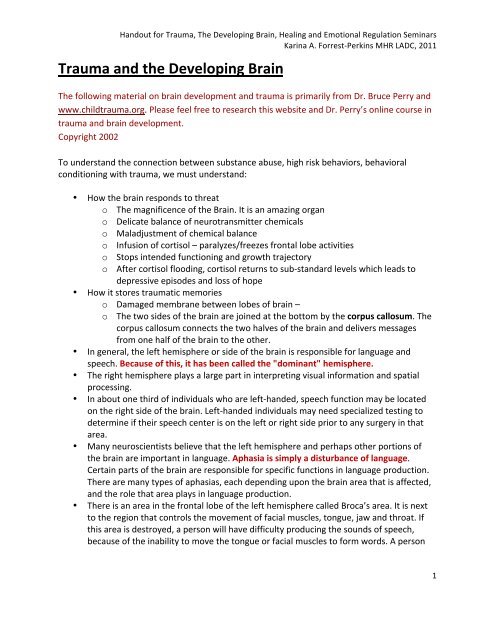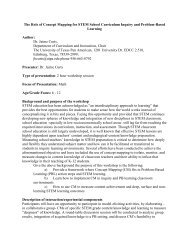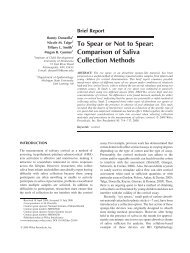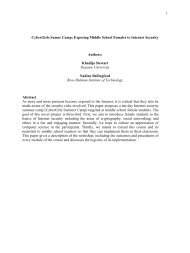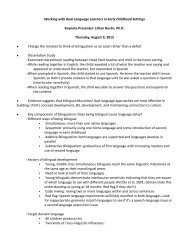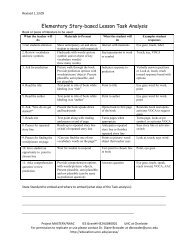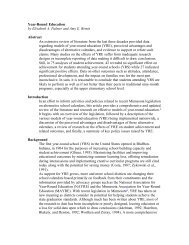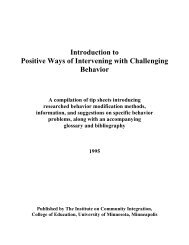Trauma and the Developing Brain - College of Education & Human ...
Trauma and the Developing Brain - College of Education & Human ...
Trauma and the Developing Brain - College of Education & Human ...
You also want an ePaper? Increase the reach of your titles
YUMPU automatically turns print PDFs into web optimized ePapers that Google loves.
H<strong>and</strong>out for <strong>Trauma</strong>, The <strong>Developing</strong> <strong>Brain</strong>, Healing <strong>and</strong> Emotional Regulation Seminars<br />
Karina A. Forrest-‐Perkins MHR LADC, 2011<br />
<strong>Trauma</strong> <strong>and</strong> <strong>the</strong> <strong>Developing</strong> <strong>Brain</strong><br />
The following material on brain development <strong>and</strong> trauma is primarily from Dr. Bruce Perry <strong>and</strong><br />
www.childtrauma.org. Please feel free to research this website <strong>and</strong> Dr. Perry’s online course in<br />
trauma <strong>and</strong> brain development.<br />
Copyright 2002<br />
To underst<strong>and</strong> <strong>the</strong> connection between substance abuse, high risk behaviors, behavioral<br />
conditioning with trauma, we must underst<strong>and</strong>:<br />
• How <strong>the</strong> brain responds to threat<br />
o The magnificence <strong>of</strong> <strong>the</strong> <strong>Brain</strong>. It is an amazing organ<br />
o Delicate balance <strong>of</strong> neurotransmitter chemicals<br />
o Maladjustment <strong>of</strong> chemical balance<br />
o Infusion <strong>of</strong> cortisol – paralyzes/freezes frontal lobe activities<br />
o Stops intended functioning <strong>and</strong> growth trajectory<br />
o After cortisol flooding, cortisol returns to sub-‐st<strong>and</strong>ard levels which leads to<br />
depressive episodes <strong>and</strong> loss <strong>of</strong> hope<br />
• How it stores traumatic memories<br />
o Damaged membrane between lobes <strong>of</strong> brain –<br />
o The two sides <strong>of</strong> <strong>the</strong> brain are joined at <strong>the</strong> bottom by <strong>the</strong> corpus callosum. The<br />
corpus callosum connects <strong>the</strong> two halves <strong>of</strong> <strong>the</strong> brain <strong>and</strong> delivers messages<br />
from one half <strong>of</strong> <strong>the</strong> brain to <strong>the</strong> o<strong>the</strong>r.<br />
• In general, <strong>the</strong> left hemisphere or side <strong>of</strong> <strong>the</strong> brain is responsible for language <strong>and</strong><br />
speech. Because <strong>of</strong> this, it has been called <strong>the</strong> "dominant" hemisphere.<br />
• The right hemisphere plays a large part in interpreting visual information <strong>and</strong> spatial<br />
processing.<br />
• In about one third <strong>of</strong> individuals who are left-‐h<strong>and</strong>ed, speech function may be located<br />
on <strong>the</strong> right side <strong>of</strong> <strong>the</strong> brain. Left-‐h<strong>and</strong>ed individuals may need specialized testing to<br />
determine if <strong>the</strong>ir speech center is on <strong>the</strong> left or right side prior to any surgery in that<br />
area.<br />
• Many neuroscientists believe that <strong>the</strong> left hemisphere <strong>and</strong> perhaps o<strong>the</strong>r portions <strong>of</strong><br />
<strong>the</strong> brain are important in language. Aphasia is simply a disturbance <strong>of</strong> language.<br />
Certain parts <strong>of</strong> <strong>the</strong> brain are responsible for specific functions in language production.<br />
There are many types <strong>of</strong> aphasias, each depending upon <strong>the</strong> brain area that is affected,<br />
<strong>and</strong> <strong>the</strong> role that area plays in language production.<br />
• There is an area in <strong>the</strong> frontal lobe <strong>of</strong> <strong>the</strong> left hemisphere called Broca’s area. It is next<br />
to <strong>the</strong> region that controls <strong>the</strong> movement <strong>of</strong> facial muscles, tongue, jaw <strong>and</strong> throat. If<br />
this area is destroyed, a person will have difficulty producing <strong>the</strong> sounds <strong>of</strong> speech,<br />
because <strong>of</strong> <strong>the</strong> inability to move <strong>the</strong> tongue or facial muscles to form words. A person<br />
1
H<strong>and</strong>out for <strong>Trauma</strong>, The <strong>Developing</strong> <strong>Brain</strong>, Healing <strong>and</strong> Emotional Regulation Seminars<br />
Karina A. Forrest-‐Perkins MHR LADC, 2011<br />
with Broca's aphasia can still read <strong>and</strong> underst<strong>and</strong> spoken language, but has difficulty<br />
speaking <strong>and</strong> writing.<br />
• There is a region in <strong>the</strong> left temporal lobe called Wernicke's area. Damage to this area<br />
causes Wernicke's aphasia. An individual can make speech sounds, but <strong>the</strong>y are<br />
meaningless (receptive aphasia) because <strong>the</strong>y do not make any sense.<br />
• American Association <strong>of</strong> Neurological Surgeons<br />
• How <strong>the</strong> brain is altered by <strong>the</strong> traumatic experience.<br />
All experience changes <strong>the</strong> brain – good experiences like piano lessons <strong>and</strong> bad experiences<br />
like living through a tornado as it destroys your home. This is so because <strong>the</strong> brain is designed<br />
to change in response to patterned, repetitive stimulation. And <strong>the</strong> stimulation associated with<br />
fear <strong>and</strong> trauma changes <strong>the</strong> brain.<br />
Over <strong>the</strong> last twenty years, neuroscientists studying <strong>the</strong> brain have learned how fear <strong>and</strong><br />
trauma influence <strong>the</strong> mature brain, <strong>and</strong> more recently, <strong>the</strong> developing brain. It is increasingly<br />
clear that experience in childhood has relatively more impact on <strong>the</strong> developing child than<br />
experiences later in life. This is due to <strong>the</strong> simple principles <strong>of</strong> neurodevelopment.<br />
The functional capabilities <strong>of</strong> <strong>the</strong> mature brain develop throughout life, but <strong>the</strong> vast majority<br />
<strong>of</strong> critical structural <strong>and</strong> functional organization takes place in childhood. Indeed, by <strong>the</strong> age<br />
<strong>of</strong> three <strong>the</strong> brain has reached 90 % <strong>of</strong> adult size, while <strong>the</strong> body is still only about 18 % <strong>of</strong><br />
adult size. By shaping <strong>the</strong> developing brain, experiences <strong>of</strong> childhood define <strong>the</strong> adult.<br />
Neurodevelopment is characterized by:<br />
(1) sequential development <strong>and</strong> ‘sensitivity’ (<strong>the</strong> brain "grows" from brainstem to <strong>the</strong> cortex)<br />
(2) ‘use-‐dependent’ organization ("use it or lose it"). The mature organization <strong>and</strong> functional<br />
capabilities <strong>of</strong> brain reflect aspects <strong>of</strong> <strong>the</strong> quantity, quality <strong>and</strong> pattern <strong>of</strong> <strong>the</strong> somato-‐sensory<br />
experiences <strong>of</strong> <strong>the</strong> first years <strong>of</strong> life.<br />
The sequential <strong>and</strong> use-‐dependent properties <strong>of</strong> brain development result in an amazing<br />
adaptive malleability, ensuring that, within its specific genetic potential, an individual’s brain<br />
develops capabilities suited for <strong>the</strong> ‘type’ <strong>of</strong> environment he or she is raised in.<br />
Simply stated, children reflect <strong>the</strong> world in which <strong>the</strong>y are raised. If that world is<br />
characterized by threat, chaos, unpredictability, fear <strong>and</strong> trauma, <strong>the</strong> brain will reflect that by<br />
altering <strong>the</strong> development <strong>of</strong> <strong>the</strong> neural systems involved in <strong>the</strong> stress <strong>and</strong> fear response.<br />
2
H<strong>and</strong>out for <strong>Trauma</strong>, The <strong>Developing</strong> <strong>Brain</strong>, Healing <strong>and</strong> Emotional Regulation Seminars<br />
Karina A. Forrest-‐Perkins MHR LADC, 2011<br />
The Neurobiological Responses to Threat<br />
When a child is threatened, various neurophysiological <strong>and</strong> neuroendocrine responses are<br />
initiated. If <strong>the</strong>y persist, <strong>the</strong>re will be ‘use-‐dependent’ alterations in <strong>the</strong> key neural systems<br />
involved in <strong>the</strong> stress response. These include <strong>the</strong> hypothalamic-‐pituitary-‐adrenal (HPA) axis.<br />
In animal models, chronic activation <strong>of</strong> <strong>the</strong> HPA system in response to stress has negative<br />
consequences. Chronic activation may "wear out" parts <strong>of</strong> <strong>the</strong> body including <strong>the</strong> hippocampus,<br />
a key area involved in memory, cognition <strong>and</strong> arousal. This may be occurring in traumatized<br />
children as well. Dr. Martin Teicher <strong>and</strong> colleagues have demonstrated hippocampal/limbic<br />
abnormalities in a sample <strong>of</strong> abused children.<br />
Ano<strong>the</strong>r set <strong>of</strong> neural systems that become sensitized by repetitive stressful experiences are<br />
<strong>the</strong> catecholamine systems including <strong>the</strong> dopaminergic <strong>and</strong> noradrenergic systems. These key<br />
neurochemical systems become altered following traumatic stress. The result is a cascade <strong>of</strong><br />
associated changes in attention, impulse control, sleep, fine motor control <strong>and</strong> o<strong>the</strong>r<br />
functions mediated by <strong>the</strong> catecholamines.<br />
As <strong>the</strong>se catecholamines <strong>and</strong> <strong>the</strong>ir target regions (e.g., amygdaloid nuclei) also mediate a<br />
variety <strong>of</strong> o<strong>the</strong>r emotional, cognitive <strong>and</strong> motor functions, sensitization <strong>of</strong> <strong>the</strong>se systems by<br />
repetitive re-‐experiencing <strong>of</strong> <strong>the</strong> trauma leads to dysregulation in many functions.<br />
A traumatized child may, <strong>the</strong>refore, exhibit motor hyperactivity, anxiety, behavioral impulsivity,<br />
sleep problems, tachycardia <strong>and</strong> hypertension. In preliminary studies by our group, we have<br />
seen altered cardiovascular regulation (e.g., increased resting heartrate) suggesting altered<br />
autonomic regulation at <strong>the</strong> level <strong>of</strong> <strong>the</strong> brainstem. In o<strong>the</strong>r studies, clonidine, an alpha2<br />
adrenergic receptor partial agonist has been demonstrated to be an effective<br />
pharmaco<strong>the</strong>rapeutic agent, presumably by altering <strong>the</strong> sensitivity <strong>of</strong> <strong>the</strong> noradrenergic<br />
systems.<br />
Implications <strong>of</strong> <strong>Trauma</strong>-‐related Alterations in <strong>Brain</strong> Development<br />
All experiences change <strong>the</strong> brain – yet not all experiences have equal ‘impact’ on <strong>the</strong> brain.<br />
Because <strong>the</strong> brain is organizing at such an explosive rate in <strong>the</strong> first years <strong>of</strong> life, experiences<br />
during this period have more potential to influence <strong>the</strong> brain – in positive <strong>and</strong> negative ways.<br />
<strong>Trauma</strong>tic experiences <strong>and</strong> <strong>the</strong>rapeutic experiences impact <strong>the</strong> same brain <strong>and</strong> are limited by<br />
3
H<strong>and</strong>out for <strong>Trauma</strong>, The <strong>Developing</strong> <strong>Brain</strong>, Healing <strong>and</strong> Emotional Regulation Seminars<br />
Karina A. Forrest-‐Perkins MHR LADC, 2011<br />
<strong>the</strong> same principles <strong>of</strong> neurophysiology. <strong>Trauma</strong>tic events impact <strong>the</strong> multiple areas <strong>of</strong> <strong>the</strong><br />
brain that respond to <strong>the</strong> threat. Use-‐dependent changes in <strong>the</strong>se areas create altered neural<br />
systems that influence future functioning. In order to heal (i.e., alter or modify trauma),<br />
<strong>the</strong>rapeutic interventions must activate those portions <strong>of</strong> <strong>the</strong> brain that have been altered by<br />
<strong>the</strong> trauma. Underst<strong>and</strong>ing <strong>the</strong> persistence <strong>of</strong> fear-‐related emotional, behavioral, cognitive <strong>and</strong><br />
physiological patterns can lead to focused <strong>the</strong>rapeutic experiences that modify those parts <strong>of</strong><br />
<strong>the</strong> brain impacted by trauma.<br />
Our evolving underst<strong>and</strong>ing <strong>of</strong> neurodevelopment suggests directions for assessment,<br />
intervention <strong>and</strong> policy. Primary among <strong>the</strong>se is a clear rationale for early identification <strong>and</strong><br />
aggressive, pro-‐active interventions that will improve our ability to help traumatized <strong>and</strong><br />
neglected children. The earlier we intervene, <strong>the</strong> more likely we will be to preserve <strong>and</strong> express<br />
a child’s potential.<br />
Long Term Effects <strong>of</strong> Abuse <strong>and</strong> <strong>Trauma</strong><br />
The American Psychiatric Association’s Diagnostic <strong>and</strong> Statistical Manual, Revised<br />
(DSM-‐IV-‐R) defines a “traumatic event” as one in which a person experiences,<br />
witnesses, or is confronted with actual or threatened death or serious injury, or threat<br />
to <strong>the</strong> physical integrity <strong>of</strong> oneself or o<strong>the</strong>rs. A person’s response to trauma <strong>of</strong>ten<br />
includes intense fear, helplessness, or horror.<br />
1 Histories <strong>of</strong> physical <strong>and</strong> sexual abuse are commonplace among incarcerated women.<br />
Women’s violent <strong>of</strong>fences tend to be reactive in nature. As a result, violent crimes<br />
are more <strong>of</strong>ten committed against intimates, not strangers.<br />
·∙ Of <strong>the</strong> 68 women serving a life sentence for murdering <strong>the</strong>ir intimate partners, <strong>the</strong><br />
majority had been abused by <strong>the</strong>ir partners prior to <strong>the</strong>ir use <strong>of</strong> lethal force.<br />
2 Child sexual abuse has come to be widely regarded as a cause <strong>of</strong> mental health issues<br />
in adult life. There is also a considerable overlap between physical, emotional <strong>and</strong><br />
sexual abuse, <strong>and</strong> children who are subject to one form <strong>of</strong> abuse are significantly<br />
more likely to have experienced o<strong>the</strong>r forms <strong>of</strong> abuse.<br />
3 Between 51% <strong>and</strong> 98% <strong>of</strong> public mental health clients diagnosed with severe mental<br />
illness have trauma histories,<br />
4 <strong>and</strong> prevalence rates within substance abuse treatment programs <strong>and</strong> o<strong>the</strong>r social services<br />
are similar. In children, trauma may be incorrectly<br />
diagnosed as depression, attention deficit hyperactivity disorder (ADHD),<br />
oppositional defiant disorder (ODD), conduct disorder, generalized anxiety disorder,<br />
separation anxiety disorder, <strong>and</strong> reactive attachment disorder.<br />
4
H<strong>and</strong>out for <strong>Trauma</strong>, The <strong>Developing</strong> <strong>Brain</strong>, Healing <strong>and</strong> Emotional Regulation Seminars<br />
Karina A. Forrest-‐Perkins MHR LADC, 2011<br />
5 A r<strong>and</strong>om community sample found women who reported histories <strong>of</strong> childhood<br />
sexual abuse were more likely to have work histories that placed <strong>the</strong>m in <strong>the</strong> lowest<br />
socio-‐economic status categories. Abuse in <strong>the</strong> home can drive women <strong>and</strong> girls into <strong>the</strong> streets,<br />
<strong>and</strong> lack <strong>of</strong> housing puts <strong>the</strong>m at fur<strong>the</strong>r serious risk <strong>of</strong> physical <strong>and</strong> sexual violence <strong>and</strong> early death.<br />
One study found that 87% <strong>of</strong> homeless girls <strong>and</strong> women aged 12 to 19 in British Columbia<br />
had been abused.<br />
6<br />
1 American Psychiatric Association, Diagnostic <strong>and</strong> Statistical Manual <strong>of</strong> Mental Disorder, Reviseds (DSM<br />
IV-‐R) 4th ed. Washington, DC: APA, 2000).<br />
2 Lise Addario, Six Degrees from Liberation: Legal Needs <strong>of</strong> Women in Criminal <strong>and</strong> O<strong>the</strong>r Matters<br />
(Research <strong>and</strong> Statistics Report) (Ottawa: Department <strong>of</strong> Justice, 2002).<br />
3 Paul Mullen & Jillian Fleming, “Long-‐term Effects <strong>of</strong> Child Sexual Abuse” (1998) 9 Issues in Child<br />
Abuse Prevention.<br />
4 Mueser Goodman et al., “<strong>Trauma</strong> <strong>and</strong> post-‐traumatic stress disorder in severe mental illness” (1998) 66<br />
Journal <strong>of</strong> Consulting <strong>and</strong> Clinical Psychology, at 493.<br />
5 Center for Substance Abuse Treatment. Substance abuse treatment for persons with child abuse <strong>and</strong><br />
neglect issues Treatment Improvement Protocol (TIP) series. Washington, DC: U.S. Government Printing<br />
Office, 2000).<br />
6Canadian Research Institute for <strong>the</strong> Advancement <strong>of</strong> Women, “New Federal Policies Affecting Women’s<br />
Equality: Reality Check” (2006) 8 Factsheet.<br />
RESOURCES:<br />
Prevent Child Abuse, America<br />
Prevent Child Abuse (formerly <strong>the</strong> National Committee to Prevent Child Abuse) is nationally recognized as<br />
one <strong>of</strong> <strong>the</strong> most innovative leaders in child abuse prevention. It has a nationwide network <strong>of</strong> chapters <strong>and</strong><br />
<strong>the</strong>ir local affiliates in hundreds <strong>of</strong> communities. Through our media campaigns, people are finding ways<br />
<strong>the</strong>y can help prevent abuse. PCA seeks to equip pr<strong>of</strong>essionals with <strong>the</strong> latest, proven prevention approaches<br />
through training <strong>and</strong> technical assistance. To find out more about your local affiliate <strong>and</strong> <strong>the</strong> national<br />
program activities contact:<br />
Prevent Child Abuse America<br />
200 S. Michigan Avenue, 17th Floor<br />
Chicago, Illinois 60604-‐2404<br />
(800) CHILDREN<br />
Tel: (312) 663-‐3520<br />
Fax: (312) 939-‐8962<br />
www.preventchildabuse.org<br />
mailbox@preventchildabuse.org<br />
5
H<strong>and</strong>out for <strong>Trauma</strong>, The <strong>Developing</strong> <strong>Brain</strong>, Healing <strong>and</strong> Emotional Regulation Seminars<br />
Karina A. Forrest-‐Perkins MHR LADC, 2011<br />
Prevent Child Abuse Minnesota<br />
Karina Forrest-‐Perkins MHR LADC<br />
Executive Director<br />
www.pcamn.org<br />
651-‐523-‐0099<br />
Child Welfare League <strong>of</strong> America<br />
CWLA is an association <strong>of</strong> more than 1,000 public <strong>and</strong> private nonpr<strong>of</strong>it agencies that assist over<br />
2.5 million abused <strong>and</strong> neglected children <strong>and</strong> <strong>the</strong>ir families each year with a wide range <strong>of</strong> services.<br />
There have many resources for families <strong>and</strong> pr<strong>of</strong>essionals working with traumatized children.<br />
For more information contact:<br />
Child Welfare League <strong>of</strong> America<br />
440 First Street, NW, Third Floor<br />
Washington, DC 20001-‐2085<br />
Tel. (202) 638-‐2952<br />
FAX (202) 638-‐4004<br />
http://www.cwla.org/<br />
American Pr<strong>of</strong>essional Society on <strong>the</strong> Abuse <strong>of</strong> Children (APSAC)<br />
APSAC's mission is to ensure that everyone affected by child maltreatment receives <strong>the</strong> best possible<br />
pr<strong>of</strong>essional response. This organization has many useful scholarly <strong>and</strong> clinical materials focused<br />
primarily at <strong>the</strong> pr<strong>of</strong>essional audience. Caregivers working with abused or maltreated children may find<br />
this a useful resource, none<strong>the</strong>less. For more information contact:<br />
APSAC<br />
407 South Dearborn Street Suite 1300<br />
Chicago, IL 60605<br />
http://www.apsac.org/<br />
The National Center for PTSD<br />
The National Center for PTSD is a program <strong>of</strong> <strong>the</strong> U.S. Department <strong>of</strong> Veterans Affairs <strong>and</strong> carries out<br />
a broad range <strong>of</strong> activities in research, training, <strong>and</strong> public information. The primary focus <strong>of</strong> <strong>the</strong> Center<br />
has been combat veterans <strong>and</strong> <strong>the</strong>ir families. Over <strong>the</strong> last few years, however, this focus has been exp<strong>and</strong>ed.<br />
There are many useful programs, activities <strong>and</strong> resources for anyone interested in <strong>the</strong> effects <strong>of</strong><br />
traumatic stressors.<br />
The PILOTS database is an electronic index to <strong>the</strong> worldwide literature on PTSD <strong>and</strong> o<strong>the</strong>r mental-‐health<br />
sequelae <strong>of</strong> exposure to traumatic events. It is available to Internet users through <strong>the</strong> courtesy <strong>of</strong> Dartmouth<br />
<strong>College</strong>, whose computer facilities serve as host to <strong>the</strong> database. No account or password is required, <strong>and</strong><br />
<strong>the</strong>re is no charge for using <strong>the</strong> PILOTS database.<br />
6
H<strong>and</strong>out for <strong>Trauma</strong>, The <strong>Developing</strong> <strong>Brain</strong>, Healing <strong>and</strong> Emotional Regulation Seminars<br />
Karina A. Forrest-‐Perkins MHR LADC, 2011<br />
The National Center for PTSD<br />
http://www.dartmouth.edu/dms/ptsd/<br />
International Society for <strong>Trauma</strong>tic Stress Study (ISTSS)<br />
The International Society for <strong>Trauma</strong>tic Stress Studies (ISTSS), founded in 1985, provides a forum<br />
for <strong>the</strong> sharing <strong>of</strong> research, clinical strategies, public policy concerns <strong>and</strong> <strong>the</strong>oretical formulations on<br />
trauma in <strong>the</strong> United States <strong>and</strong> around <strong>the</strong> world. ISTSS is dedicated to <strong>the</strong> discovery <strong>and</strong> dissemination<br />
<strong>of</strong> knowledge <strong>and</strong> to <strong>the</strong> stimulation <strong>of</strong> policy, program <strong>and</strong> service initiatives that seek to reduce<br />
traumatic stressors <strong>and</strong> <strong>the</strong>ir immediate <strong>and</strong> long-‐term consequences.<br />
ISTSS<br />
60 Revere Drive, Suite 500<br />
Northbrook, Illinois 60062 USA<br />
Phone: 847/480-‐9028; Fax: 847/480-‐9282<br />
http://www.istss.org<br />
The Harvard Center for <strong>the</strong> <strong>Developing</strong> Child<br />
http://developingchild.harvard.edu/<br />
The Israel Center for <strong>the</strong> Treatment <strong>of</strong> Psychotrauma<br />
The Israel Center for <strong>the</strong> Treatment <strong>of</strong> Psychotrauma is a non-‐pr<strong>of</strong>it organization dedicated to improve<br />
<strong>the</strong> lives <strong>of</strong> those who suffer from trauma <strong>and</strong> stress, <strong>and</strong> <strong>the</strong>ir families. The <strong>Trauma</strong>web site contains<br />
information regarding trauma, stress, resiliency <strong>and</strong> coping, <strong>and</strong> <strong>of</strong>fers useful advice <strong>and</strong> self-‐help<br />
strategies by <strong>the</strong> center’s pr<strong>of</strong>essional staff. mail@traumaweb.org<br />
National Clearinghouse for Child Abuse <strong>and</strong> Neglect (NCCAN)<br />
The National Clearinghouse on Child Abuse <strong>and</strong> Neglect Information is a national resource<br />
for pr<strong>of</strong>essionals seeking information on <strong>the</strong> prevention, identification, <strong>and</strong> treatment <strong>of</strong> child<br />
abuse <strong>and</strong> neglect, <strong>and</strong> related child welfare issues.<br />
NCCAN<br />
330 C Street, SW<br />
Washington, DC 20447<br />
Phone: (800) 394-‐3366 or (703) 385-‐7565<br />
Fax: (703) 385-‐3206<br />
http://www.calib.com/nccanch<br />
nccanch@calib.com<br />
National Information, Support <strong>and</strong> Referral Service on Shaken Baby Syndrome<br />
The Child Abuse Prevention Center <strong>of</strong> Utah hosts this useful website about Shaken Baby<br />
Syndrome (SBS). In addition, <strong>the</strong>y publish a quarterly newsletter featuring articles targeted for<br />
pr<strong>of</strong>essionals as well as family members that deal with SBS. Articles are written by experts in<br />
medicine, legal pr<strong>of</strong>ession, investigative, law enforcement <strong>and</strong> from parents or family members <strong>of</strong><br />
7
H<strong>and</strong>out for <strong>Trauma</strong>, The <strong>Developing</strong> <strong>Brain</strong>, Healing <strong>and</strong> Emotional Regulation Seminars<br />
Karina A. Forrest-‐Perkins MHR LADC, 2011<br />
victims. The newsletter is avaliable both on-‐line <strong>and</strong> in print. If you are interested in receiving this<br />
publication please email <strong>the</strong>m at capcente@ix.netcom.com <strong>and</strong> <strong>the</strong>y will add you to <strong>the</strong>ir mailing list.<br />
National Information, Support <strong>and</strong> Referral Service on SBS<br />
2955 Harrison Blvd., #102<br />
Ogden, UT 84403<br />
(801) 393-‐3366<br />
Fax: (801) 394-‐1781<br />
http://www.capcenter.org<br />
capcente@ix.netcom.com<br />
David Baldwin’s <strong>Trauma</strong> Information Pages<br />
These <strong>Trauma</strong> Pages focus primarily on emotional trauma <strong>and</strong> traumatic stress, including<br />
PTSD (Post-‐traumatic Stress Disorder), whe<strong>the</strong>r following individual traumatic experience(s) or<br />
a large-‐scale disaster. New information is added to this site about once a month. The purpose <strong>of</strong><br />
this award-‐winning site is to provide information for clinicians <strong>and</strong> researchers in <strong>the</strong><br />
traumatic-‐stress field. Baldwin’s interests include both clinical <strong>and</strong> research aspects <strong>of</strong> trauma<br />
responses <strong>and</strong> <strong>the</strong>ir resolution. For example:<br />
1. What goes on biologically in <strong>the</strong> brain during traumatic experience <strong>and</strong> its resolution?<br />
2. Which psycho<strong>the</strong>rapeutic procedures are most effective for which patients with traumatic<br />
symptoms, <strong>and</strong> why?<br />
3. How can we best measure clinical efficacy <strong>and</strong> treatment outcome for trauma survivor populations?<br />
Supportive resources supplement <strong>the</strong> more academic or research information <strong>of</strong> interest to clinicians,<br />
researchers, <strong>and</strong> students.<br />
David Baldwin’s <strong>Trauma</strong> Information Pages<br />
http://www.trauma-‐pages.com<br />
Red Cross<br />
The American Red Cross has a long history <strong>of</strong> helping children, families <strong>and</strong> communities<br />
recover from disasters. This experience has resulted in an increasing awareness <strong>of</strong> <strong>the</strong> need for<br />
quality mental health education <strong>and</strong> preventative approaches to minimize <strong>the</strong> long-‐term effects <strong>of</strong><br />
traumatic disaster. With special experience for trauma resulting from natural disasters, this<br />
organization has a network <strong>of</strong> mental health pr<strong>of</strong>essionals capable <strong>of</strong> immediate response to help a<br />
community organize <strong>and</strong> focus <strong>the</strong>ir resources following traumatic events. One <strong>of</strong> <strong>the</strong> primary<br />
partners in this effort is <strong>the</strong> Disaster Mental Health Institute in South Dakota. Ei<strong>the</strong>r <strong>of</strong> <strong>the</strong>se resources<br />
are excellent places to start.<br />
The Red Cross<br />
8
http://www.redcross.org/<br />
H<strong>and</strong>out for <strong>Trauma</strong>, The <strong>Developing</strong> <strong>Brain</strong>, Healing <strong>and</strong> Emotional Regulation Seminars<br />
Karina A. Forrest-‐Perkins MHR LADC, 2011<br />
Disaster Mental Health Institute<br />
University <strong>of</strong> South Dakota -‐ SDU116<br />
414 East Clark Street<br />
Vermillion SD 57069-‐2390<br />
E-‐mail: dmhi@usd.edu<br />
Resources on Assessment<br />
Collaborative Family Healthcare Coalition (CFHC) is a diverse group <strong>of</strong> physicians, nurses,<br />
psychologists, social workers, family <strong>the</strong>rapists <strong>and</strong> o<strong>the</strong>r health care workers, working in both<br />
primary <strong>and</strong> tertiary care settings, who study, implement, <strong>and</strong> advocate for <strong>the</strong> collaborative<br />
family health care paradigm.<br />
CFHCC<br />
40 W. 12 th Street<br />
New York, NY 10011-‐8604<br />
(212) 675-‐2477<br />
http://www.cfhcc.org<br />
NEW -‐ Childstats.gov <strong>of</strong>fers easy access to federal <strong>and</strong> state statistics <strong>and</strong> reports on<br />
children <strong>and</strong> <strong>the</strong>ir families, including: population <strong>and</strong> family characteristics, economic security,<br />
health, behavior <strong>and</strong> social environment,<strong>and</strong> education.<br />
http://www.childstats.gov/<br />
The Barr-‐Harris Children's Grief Center in Chicago, Illinois is dedicated to helping children<br />
facing <strong>the</strong> pain <strong>of</strong> death, divorce, separation, or ab<strong>and</strong>onment. This unique Center has many<br />
useful resources including an excellent web site. This site has an excellent bibliography <strong>of</strong><br />
pr<strong>of</strong>essional <strong>and</strong> personal resources for this issue. Included is a list <strong>of</strong> books for children.<br />
The Barr-‐Harris Children’s Grief Center<br />
Institute for Psychoanalysis<br />
122 S. Michigan Ave., Suite 1300<br />
Chicago, IL 60603<br />
http://www.barrharris.org<br />
Am<strong>and</strong>a <strong>the</strong> P<strong>and</strong>a provides support to grieving children <strong>and</strong> <strong>the</strong>ir families through a variety<br />
<strong>of</strong> services. Extensive support is provided to children who are grieving <strong>the</strong> death <strong>of</strong> a family<br />
member through accident, illness, suicide, or homicide. This support is provided through weekend<br />
camps, support groups, home visits, fun days, school presentations, holiday cheer boxes, pen pal<br />
programs, Halloween <strong>and</strong> Christmas parties, birthday cards <strong>and</strong> remembrances, on <strong>the</strong> anniversary<br />
<strong>of</strong> <strong>the</strong> death. All services are provided at no cost to children <strong>and</strong> families served.<br />
9
H<strong>and</strong>out for <strong>Trauma</strong>, The <strong>Developing</strong> <strong>Brain</strong>, Healing <strong>and</strong> Emotional Regulation Seminars<br />
Karina A. Forrest-‐Perkins MHR LADC, 2011<br />
Am<strong>and</strong>a <strong>the</strong> P<strong>and</strong>a<br />
http://www.am<strong>and</strong>a<strong>the</strong>p<strong>and</strong>a.org<br />
or contact:<br />
JoAnn Zimmerman<br />
1000 73 rd Street, Suite 12,<br />
Des Moines, IA 50311<br />
jzp<strong>and</strong>a@netins.net<br />
(515) 223-‐4847<br />
FAX: (515) 223-‐4782<br />
Julie’s Place is a unique web site developed by a young woman who lost her sister in<br />
a traumatic event. This site is designed to help siblings <strong>of</strong> dealing with traumatic loss. It has areas<br />
listing o<strong>the</strong>r resources, a place for siblings to e-‐communicate using a message board, <strong>and</strong> a list<br />
<strong>of</strong> personal narratives. This site is likely to be very helpful to older children <strong>and</strong> adolescents.<br />
Julie’s Place<br />
http://www.juliesplace.com<br />
OTHER REGIONAL RESOURCES ON LOSS AND GRIEVING:<br />
The Dougy Center<br />
P.O. Box 86852<br />
Portl<strong>and</strong>, Oregon 97286<br />
www.dougy.org<br />
Fernside, A Center for Grieving Children<br />
2303 Indian Mound Avenue<br />
Cincinnati, Ohio 45212<br />
(513) 841-‐1012<br />
www.fernside.org<br />
Center for Loss <strong>and</strong> Life Transition<br />
3735 Broken Bow Road<br />
Fort Collins, CO 80526<br />
www.counselingforloss.com<br />
Bo's Place<br />
5501 Austin<br />
10
P.O. Box 271165<br />
Houston, Texas 77277-‐1165<br />
Phone: (713) 942 -‐ 8339<br />
Fax: (713) 942 – 2252<br />
H<strong>and</strong>out for <strong>Trauma</strong>, The <strong>Developing</strong> <strong>Brain</strong>, Healing <strong>and</strong> Emotional Regulation Seminars<br />
Karina A. Forrest-‐Perkins MHR LADC, 2011<br />
PROTECT is a national pro-‐child, anti-‐crime membership association founded on <strong>the</strong> belief<br />
that our first <strong>and</strong> most sacred obligation as parents, citizens, <strong>and</strong> members <strong>of</strong> <strong>the</strong> human species<br />
is <strong>the</strong> protection <strong>of</strong> children from harm. Protect <strong>and</strong> its members are committed to building a powerful,<br />
nonpartisan force for <strong>the</strong> protection <strong>of</strong> children from abuse, exploitation <strong>and</strong> neglect. Members believe<br />
that this must be done through a determined single-‐issue focus, a meaningful mainstream agenda<br />
<strong>and</strong> <strong>the</strong> use <strong>of</strong> proven modern political strategies.<br />
www.protect.org<br />
46 Haywood Street, Suite 315, Asheville, NC 28801<br />
phone: (828) 350-‐9350 -‐ email: info@protect.org<br />
Child Welfare Training Resources Online Network is designed to assist <strong>the</strong> child welfare training<br />
community to identify <strong>and</strong> share training resources, activities, curricula, <strong>and</strong> materials aimed at<br />
enhancing <strong>the</strong> skills <strong>and</strong> qualifications <strong>of</strong> <strong>the</strong> child welfare workforce. By serving as a central repository<br />
<strong>and</strong> conduit for child welfare training information from across <strong>the</strong> United States, <strong>the</strong> Project<br />
facilitates <strong>the</strong> connection <strong>of</strong> trainers <strong>and</strong> practitioners to resources <strong>and</strong> services that meet <strong>the</strong>ir<br />
training needs. The CWTR Project is managed by <strong>the</strong> National Clearinghouse on Child Abuse <strong>and</strong><br />
Neglect Information, a service <strong>of</strong> <strong>the</strong> Children's Bureau.<br />
Child Welfare Training Resources Online Network<br />
National Clearinghouse on Child Abuse <strong>and</strong> Neglect Information<br />
330 C Street, SW<br />
Washington, D.C. 20447<br />
1-‐800-‐394-‐3366<br />
http://www.childwelfaretraining.org<br />
(go to "National Organizations" <strong>and</strong> <strong>the</strong>n scroll through <strong>the</strong>ir alphabetical list <strong>of</strong> resources)<br />
Office <strong>of</strong> Juvenile Justice <strong>and</strong> Delinquency Prevention (OJJDP), Department <strong>of</strong> Justice is <strong>the</strong> division<br />
<strong>of</strong> <strong>the</strong> Justice Department dedicated to <strong>the</strong> shaping <strong>and</strong> enacting federal policy regarding <strong>the</strong> areas <strong>of</strong><br />
juvenile justice. As it carries out this mission, <strong>the</strong> OJJDP is works with states <strong>and</strong> o<strong>the</strong>r non-‐government<br />
agencies <strong>and</strong> organizations to develop programs to prevent <strong>and</strong> control juvenile delinquency.<br />
The OJJDP website has a wealth <strong>of</strong> information regarding <strong>the</strong> prevalence <strong>of</strong> problems as well as<br />
<strong>the</strong> documentation <strong>of</strong> promising intervention programs. OJJDP has been a primary sponsor <strong>of</strong> <strong>the</strong><br />
successful home-‐visitation models, <strong>the</strong> Safe Kids/Safe Streets project, Safe Start programs <strong>and</strong><br />
<strong>the</strong> community policing initiatives taking place in many communities.<br />
OJJDP<br />
810 Seventh Street, NW,<br />
Washington, DC 20531<br />
11
(202) 307-‐5911<br />
Fax: (202) 307-‐2093<br />
http://ojjdp.ncjrs.org<br />
E-‐mail: askjj@ojp.usdoj.gov<br />
H<strong>and</strong>out for <strong>Trauma</strong>, The <strong>Developing</strong> <strong>Brain</strong>, Healing <strong>and</strong> Emotional Regulation Seminars<br />
Karina A. Forrest-‐Perkins MHR LADC, 2011<br />
Parents <strong>and</strong> Teachers Against Violence in <strong>Education</strong>: Project NO SPANK<br />
This is an advocacy organization that has documented <strong>and</strong> catalogued materials<br />
related to <strong>the</strong> issue <strong>of</strong> physical discipline. For any individual or group interested in reading<br />
about <strong>the</strong> research regarding <strong>the</strong> adverse impact <strong>of</strong> physical discipline <strong>and</strong> spanking, this is<br />
<strong>the</strong> site to start with. Remember, this is an advocacy organization; this site will clearly <strong>and</strong><br />
strongly present <strong>the</strong>ir positions.<br />
Project No Spank<br />
P.O. Box 1033<br />
Alamo, CA 94507-‐7033<br />
(925) 831-‐1661<br />
Fax: (925) 838-‐8914<br />
E-‐mail: ptave@silcon.com<br />
http://www.nospank.net<br />
New Haven Child Development-‐Community Policing Project: (CD-‐CP)<br />
This is an innovative program which is a collaborative project <strong>of</strong> <strong>the</strong> Yale Child Study Center,<br />
<strong>the</strong> New Haven Police Department, local schools <strong>and</strong> <strong>the</strong> Connecticut child protective services.<br />
This project is designed to provide <strong>the</strong> immediate mental health needs <strong>of</strong> child crime victims <strong>and</strong><br />
witnesses. By creating special training opportunities, mental health providers <strong>and</strong> police <strong>of</strong>ficers<br />
share expertise <strong>and</strong> address <strong>the</strong> complex needs <strong>of</strong> children exposed to violence. This is an effective<br />
<strong>and</strong> unique program. The OJJDP is helping o<strong>the</strong>r communities create similar innovative collaboratives.<br />
CD-‐CP Program<br />
Suite 212<br />
47 <strong>College</strong> Street<br />
New Haven, CT 06510<br />
(203) 785-‐3377<br />
Family Violence Research Laboratory <strong>of</strong> University <strong>of</strong> New Hampshire (FRL)<br />
This organization is a pioneer in conducting research <strong>and</strong> education in <strong>the</strong> area <strong>of</strong> domestic<br />
<strong>and</strong> violence in childhood. Since 1975, <strong>the</strong> Family Research Laboratory (FRL) has devoted itself<br />
primarily to underst<strong>and</strong>ing family violence <strong>and</strong> <strong>the</strong> impact <strong>of</strong> violence in families. This organization<br />
<strong>and</strong> its website are a highly recommended resource for quality research, reviews <strong>and</strong> thoughtful<br />
policy <strong>and</strong> practice recommendations.<br />
As public <strong>and</strong> pr<strong>of</strong>essional interest in family violence has grown, so has <strong>the</strong> need for more<br />
reliable knowledge. The FRL has tried to fill that need in a variety <strong>of</strong> ways: through comprehensive<br />
literature reviews, new <strong>the</strong>ories, <strong>and</strong> methodologically sound studies. Researchers at <strong>the</strong> FRL<br />
12
H<strong>and</strong>out for <strong>Trauma</strong>, The <strong>Developing</strong> <strong>Brain</strong>, Healing <strong>and</strong> Emotional Regulation Seminars<br />
Karina A. Forrest-‐Perkins MHR LADC, 2011<br />
pioneered many <strong>of</strong> <strong>the</strong> techniques that have enabled social scientists to estimate directly <strong>the</strong><br />
scope <strong>of</strong> family violence. These efforts have brought international recognition to <strong>the</strong> FRL.<br />
FRL<br />
126 Horton Social Science Center<br />
Durham, NH 03824-‐1888<br />
(603) 862-‐1888<br />
Fax: (603) 862-‐1122<br />
E-‐mail: mas2@christa.unh.edu<br />
http://www.unh.edu/frl<br />
Zero to Three is a national, nonpr<strong>of</strong>it organization located in Washington, D.C., dedicated<br />
solely to advancing <strong>the</strong> healthy development <strong>of</strong> babies <strong>and</strong> young children. Founded in l977 by<br />
top developmental experts, ZERO TO THREE disseminates key developmental information, trains<br />
providers, promotes model approaches <strong>and</strong> st<strong>and</strong>ards <strong>of</strong> practice <strong>and</strong> works to increase public<br />
awareness about <strong>the</strong> significance <strong>of</strong> <strong>the</strong> first three years <strong>of</strong> life.<br />
Zero to Three<br />
734 15th Street, NW, Suite 1000<br />
Washington, DC 20005<br />
(202) 638-‐1144.<br />
http://www.zerotothree.org<br />
PACT, An Adoption Alliance A nonpr<strong>of</strong>it 501(c)(3) organization begun by two adoptive parents<br />
in 1991, Pact has developed a national reputation for excellence in serving all members <strong>of</strong> <strong>the</strong><br />
adoption triad. Each year, Pact <strong>of</strong>fers educational events attended by more than 1500 individuals,<br />
provides -‐ free <strong>of</strong> charge -‐ over 1000 crisis consultations to birth parents, <strong>and</strong> consults with<br />
hundreds <strong>of</strong> potential adoptive parents. Top priority is given to programs especially designed to<br />
support <strong>and</strong> inform adopted children <strong>and</strong> adopted adults <strong>of</strong> color.<br />
PACT<br />
3450 Sacramento Street Suite 239<br />
San Francisco, CA 94118<br />
(415) 221-‐6957<br />
(510) 482-‐2089 FAX<br />
e-‐mail: info@pactadopt.org<br />
http://www.pactadopt.org<br />
Attachment Parenting International is a coalition <strong>of</strong> concerned individuals, pr<strong>of</strong>essionals,<br />
<strong>and</strong> grassroots organizations. They advocate special "attachment parenting" methods to<br />
develop <strong>and</strong> fulfill a child's need for trust, empathy, <strong>and</strong> affection in order to create secure <strong>and</strong><br />
enduring relationships. This organization feels that attachment parenting, in conjunction with<br />
support groups can not only streng<strong>the</strong>n families but provide a simple <strong>and</strong> cost-‐effective model<br />
to aid in <strong>the</strong> prevention <strong>of</strong> child abuse, behavioral disorders, criminal acts, <strong>and</strong> o<strong>the</strong>r serious social<br />
problems.<br />
13
H<strong>and</strong>out for <strong>Trauma</strong>, The <strong>Developing</strong> <strong>Brain</strong>, Healing <strong>and</strong> Emotional Regulation Seminars<br />
Karina A. Forrest-‐Perkins MHR LADC, 2011<br />
Attachment Parenting International<br />
1508 Clairmont Place<br />
Nashville, Tennessee 37215<br />
(615) 298 4334<br />
http://www.attachmentparenting.org<br />
Resources on <strong>the</strong> <strong>Brain</strong><br />
Society for Neuroscience is <strong>the</strong> world's largest organization <strong>of</strong> scientists <strong>and</strong> physicians<br />
dedicated to underst<strong>and</strong>ing <strong>the</strong> brain, spinal cord <strong>and</strong> peripheral nervous system. This site<br />
has a number <strong>of</strong> very useful materials for pr<strong>of</strong>essionals without specific expertise in <strong>the</strong><br />
neurosciences. The educational programs <strong>and</strong> materials are well written, clear <strong>and</strong> accurate; overall<br />
an excellent resource.<br />
Society for Neuroscience<br />
11 Dupont Circle, N.W., Suite 500<br />
Washington D.C. 20036<br />
(202) 462-‐6688<br />
http://www.sfn.org<br />
info@sfn.org<br />
The <strong>Human</strong> <strong>Brain</strong>: Dissections <strong>of</strong> <strong>the</strong> Real <strong>Brain</strong><br />
You really want to see what <strong>the</strong> brain looks like? This site has a well-‐presented<br />
dissection <strong>of</strong> <strong>the</strong> human brain. It is a useful way to see what <strong>the</strong>se areas really look like.<br />
Visit this site <strong>and</strong> admire <strong>the</strong> work <strong>of</strong> Terence H. Williams, M.D., Ph.D., D.Sc.. Nedzad<br />
Gluhbegovic, M.D., Ph.D. <strong>and</strong> Jean Y. Jew, M.D.<br />
http://www.vh.org/Providers/Textbooks/<strong>Brain</strong>Anatomy/<strong>Brain</strong>Anatomy.html<br />
The Amazing <strong>Human</strong> <strong>Brain</strong> <strong>and</strong> <strong>Human</strong> Development -‐-‐ A Free, Online Course<br />
Course author <strong>and</strong> instructor Dr. Bruce Perry, M.D., Ph.D. has created brief lessons with practical<br />
information to help pr<strong>of</strong>essionals <strong>and</strong> caregivers underst<strong>and</strong> this <strong>and</strong> o<strong>the</strong>r interesting topics.<br />
Participants can discuss course content with fellow students <strong>and</strong> Dr. Perry online via <strong>the</strong> message<br />
boards. The self-‐paced courses are <strong>of</strong>fered at no cost to participants. Simply register as a<br />
student at www.Child<strong>Trauma</strong>Academy.com, enroll in <strong>the</strong> course or courses <strong>of</strong> your choice <strong>and</strong><br />
return to complete each lesson at your leisure<br />
Enroll now!<br />
http://www.childtrauma.org<br />
<strong>Brain</strong>y Babies: Build & Develop Your Babys Intelligence<br />
By Robin Fancourt, M.R.C.P. F.R.A.C.P.<br />
In this ground-‐breaking new book, Dr. Robin Fancourt takes <strong>the</strong> reader on a fascinating journey,<br />
from conception through <strong>the</strong> early years, that unravels <strong>the</strong> mysterious process <strong>of</strong> how babies<br />
14
H<strong>and</strong>out for <strong>Trauma</strong>, The <strong>Developing</strong> <strong>Brain</strong>, Healing <strong>and</strong> Emotional Regulation Seminars<br />
Karina A. Forrest-‐Perkins MHR LADC, 2011<br />
learn, underst<strong>and</strong> <strong>and</strong> relate to o<strong>the</strong>rs, become confident <strong>and</strong> succeed. By underst<strong>and</strong>ing how<br />
<strong>the</strong> brain works, we can enrich <strong>the</strong> lives children in so many ways.<br />
Dr. Robin Fancourt is a pediatrician with a special interest in young children, <strong>and</strong> those abused,<br />
neglected <strong>and</strong> disadvantaged. She has held several important positions, from President <strong>of</strong> DSAC<br />
(Doctors for Sexual Abuse Care) to founding <strong>and</strong> being <strong>the</strong> inaugural chairperson <strong>of</strong> Children's<br />
Agenda, a national organization providing advocacy for children. She is also an executive member<br />
<strong>of</strong> <strong>the</strong> council for ISPCAN (International Society for <strong>the</strong> Prevention <strong>of</strong> Child Abuse <strong>and</strong> Neglect).<br />
Dr. Fancourt has also been central in <strong>the</strong> setting up <strong>of</strong> <strong>Brain</strong>Wave, a national trust to disseminate<br />
information <strong>and</strong> lobby parliament for resources for early childhood.<br />
Available online through Penguin Books Australia<br />
http://www.penguin.com.au/<br />
ISBN: 0140296921<br />
The <strong>Trauma</strong>tic Stress Institute/ Center for Adult <strong>and</strong> Adolescent Psycho<strong>the</strong>rapy is located<br />
in South Windsor, Connecticut <strong>and</strong> has a dual mission: (1) to promote underst<strong>and</strong>ing <strong>and</strong><br />
improve treatment <strong>of</strong> traumatic stress <strong>and</strong> (2) to promote psychology as a discipline <strong>and</strong> pr<strong>of</strong>ession.<br />
This Institute has developed some very useful resources for pr<strong>of</strong>essionals struggling with<br />
secondary traumatic stress.<br />
The <strong>Trauma</strong>tic Stress Institute/<br />
Center for Adult <strong>and</strong> Adolescent Psycho<strong>the</strong>rapy<br />
22 Morgans Farms Road<br />
South Windsor, Connecticut 06074<br />
(860) 644-‐2541<br />
http://www.tsicaap.com<br />
The <strong>Trauma</strong>tology Institute is <strong>the</strong> home <strong>of</strong> psychologist, Dr. Charles Figley, a pioneer in <strong>the</strong><br />
field <strong>of</strong> compassion fatigue or secondary trauma. Dr. Figley is <strong>the</strong> founding Editor <strong>of</strong> <strong>the</strong> Journal<br />
<strong>of</strong> <strong>Trauma</strong>tic Stress <strong>and</strong> has written many articles <strong>and</strong> books on compassion fatigue or secondary<br />
traumatic stress.<br />
The <strong>Trauma</strong>tology Institute<br />
School <strong>of</strong> Social Work<br />
Florida State University<br />
C2500 University Center<br />
Tallahassee, Florida 32306-‐2570<br />
(850) 644-‐4751<br />
http://learningforlife.fsu.edu/traumatology<br />
International Society for <strong>Trauma</strong>tic Stress Studies (ISTSS), founded in 1985, provides a forum<br />
for <strong>the</strong> sharing <strong>of</strong> research, clinical strategies, public policy concerns <strong>and</strong> <strong>the</strong>oretical formulations<br />
on trauma in <strong>the</strong> United States <strong>and</strong> around <strong>the</strong> world. ISTSS is dedicated to <strong>the</strong> discovery <strong>and</strong><br />
15
H<strong>and</strong>out for <strong>Trauma</strong>, The <strong>Developing</strong> <strong>Brain</strong>, Healing <strong>and</strong> Emotional Regulation Seminars<br />
Karina A. Forrest-‐Perkins MHR LADC, 2011<br />
dissemination <strong>of</strong> knowledge <strong>and</strong> to <strong>the</strong> stimulation <strong>of</strong> policy, program <strong>and</strong> service initiatives that<br />
seek to reduce traumatic stressors <strong>and</strong> <strong>the</strong>ir immediate <strong>and</strong> long-‐term consequences.<br />
ISTSS<br />
60 Revere Drive, Suite 500<br />
Northbrook, Illinois 60062 USA<br />
(847) 480-‐9028<br />
Fax: (847) 480-‐9282<br />
http://www.istss.org<br />
National Council <strong>of</strong> Juvenile <strong>and</strong> Family Court Judges<br />
The National Council's began in 1937 when a group <strong>of</strong> leading judges sought to bring<br />
toge<strong>the</strong>r judicial <strong>of</strong>ficers working with in Juvenile <strong>and</strong> Family Courts. The purpose was two-‐fold:<br />
to focus attention on <strong>the</strong> concept <strong>of</strong> a separate tribunal for children <strong>and</strong> to encourage <strong>the</strong> development<br />
<strong>of</strong> essential treatment programs for children with special needs.<br />
Juvenile law has changed dramatically since <strong>the</strong>n, <strong>and</strong> so, too, has <strong>the</strong> National Council.<br />
Increased awareness <strong>and</strong> sensitivity to children's issues have given <strong>the</strong> Council <strong>the</strong> insight<br />
to provide meaningful assistance to judges, court administrators <strong>and</strong> related pr<strong>of</strong>essionals<br />
in whose care <strong>the</strong> concerns <strong>of</strong> children <strong>and</strong> <strong>the</strong>ir families have been entrusted. Consequently,<br />
<strong>the</strong> Council is not only <strong>the</strong> nation's oldest judicial membership organization, it is also <strong>the</strong> largest.<br />
NCJFCJ<br />
P.O. Box 8970<br />
Reno, NV 89507<br />
(702) 784-‐6628<br />
(702) 784-‐4858 Fax<br />
http://www.ncjfcj.unr.edu/<br />
National Association <strong>of</strong> Counsel for Children (NACC) is a non-‐pr<strong>of</strong>it pr<strong>of</strong>essional<br />
membership organization dedicated to quality representation <strong>and</strong> protection <strong>of</strong> children in<br />
<strong>the</strong> legal system. The purpose <strong>of</strong> <strong>the</strong> NACC is to assist attorneys <strong>and</strong> o<strong>the</strong>r pr<strong>of</strong>essionals<br />
in <strong>the</strong>ir work with children in <strong>the</strong> legal system. At <strong>the</strong> same time, <strong>the</strong> NACC carries out a Policy<br />
Agenda designed to improve <strong>the</strong> legal system for children.<br />
NACC<br />
1825 Marion Street, Suite 340<br />
Denver, CO 80218<br />
888/828-‐NACC<br />
advocate@NACCchildlaw.org<br />
http://naccchildlaw.org/<br />
ABA Center on Children <strong>and</strong> <strong>the</strong> Law<br />
16
H<strong>and</strong>out for <strong>Trauma</strong>, The <strong>Developing</strong> <strong>Brain</strong>, Healing <strong>and</strong> Emotional Regulation Seminars<br />
Karina A. Forrest-‐Perkins MHR LADC, 2011<br />
Established in 1978, <strong>the</strong> ABA Center on Children <strong>and</strong> <strong>the</strong> Law's mission is to improve children's<br />
lives through advances in law, justice, knowledge, practice, <strong>and</strong> public policy. Its work includes:<br />
• Streng<strong>the</strong>ning laws, policies, <strong>and</strong> judicial procedures affecting children<br />
• Researching <strong>and</strong> disseminating information on laws, policies, <strong>and</strong> practices affecting children/families<br />
• Enhancing skills <strong>and</strong> competence <strong>of</strong> legal pr<strong>of</strong>essionals in children's proceedings<br />
• Educating non-‐attorneys on child-‐related law <strong>and</strong> its impact on <strong>the</strong>ir work<br />
• Increasing public awareness <strong>of</strong> law <strong>and</strong> justice related to children<br />
• Stimulating <strong>and</strong> assisting activities <strong>and</strong> projects on children <strong>and</strong> <strong>the</strong> law<br />
Center on Children <strong>and</strong> <strong>the</strong> Law<br />
740 15th Street, NW<br />
Washington, DC 20005<br />
(202) 662-‐1720<br />
(202) 662-‐1755 Fax<br />
http://www.abanet.org/child/home.html<br />
This page on <strong>the</strong> <strong>the</strong>ir website is particularly useful as a resource.<br />
http://www.abanet.org/child/links.html<br />
What Exactly Is <strong>Trauma</strong>?<br />
A trauma is a psychologically distressing event that is outside <strong>the</strong> range <strong>of</strong> usual human<br />
experience. <strong>Trauma</strong> <strong>of</strong>ten involves a sense <strong>of</strong> intense fear, terror, <strong>and</strong> helplessness.<br />
<strong>Trauma</strong> should not be confused with stress. As we will learn later, stress is an inevitable<br />
component <strong>of</strong> everyone's life. <strong>Trauma</strong> is an experience that induces an abnormally intense <strong>and</strong><br />
prolonged stress response.<br />
Simply by signing up for this course, you have expressed an interest in childhood trauma <strong>and</strong><br />
perhaps count yourself or someone you love among <strong>the</strong> statistics cited above. Maybe you know<br />
a child who is a victim <strong>of</strong> childhood trauma, or are an adult still grappling with your own<br />
experience.<br />
No matter what brings you here, take a moment now <strong>and</strong> identify someone or some event in<br />
your life or work that makes this issue real. While you take this course, your own experiences<br />
with traumatic events <strong>and</strong> with children or families impacted by trauma will provide <strong>the</strong> true<br />
context for learning.<br />
17
H<strong>and</strong>out for <strong>Trauma</strong>, The <strong>Developing</strong> <strong>Brain</strong>, Healing <strong>and</strong> Emotional Regulation Seminars<br />
Karina A. Forrest-‐Perkins MHR LADC, 2011<br />
Introduction to Childhood <strong>Trauma</strong><br />
<strong>Trauma</strong>tic experiences can have a devastating impact on a child, altering his or her physical,<br />
emotional, cognitive, <strong>and</strong> social development. In turn, <strong>the</strong> impact on <strong>the</strong> child has pr<strong>of</strong>ound<br />
implications for his or her family, community <strong>and</strong>, ultimately, all <strong>of</strong> us. Caregivers, childcare<br />
providers, teachers, law enforcement, child protection workers, social workers, judges, nurses,<br />
pediatricians, <strong>and</strong> mental health service providers all will work with traumatized or maltreated<br />
children.<br />
Now that we have reviewed some <strong>of</strong> <strong>the</strong> disheartening information, let's hear some good news.<br />
With treatment, <strong>the</strong> effects <strong>of</strong> childhood trauma can be alleviated. Early <strong>and</strong> aggressive<br />
treatment <strong>of</strong> traumatized children decreases risk for developing PTSD <strong>and</strong> o<strong>the</strong>r trauma-‐related<br />
problems seen later in life.<br />
Treatments usually incorporate three elements:<br />
1. Review <strong>and</strong> recollection <strong>of</strong> <strong>the</strong> traumatic experience<br />
2. Information about <strong>the</strong> normal <strong>and</strong> expected processes <strong>of</strong> post-‐traumatic functioning<br />
3. Focus on specific symptoms<br />
Despite <strong>the</strong> positive effects we know treatment has on trauma sufferers, <strong>the</strong> unfortunate<br />
reality is that most traumatized children do not get any help whatsoever. There is a dangerous<br />
belief among adults that children are "resilient" <strong>and</strong> can wea<strong>the</strong>r trauma naturally. Those<br />
children who do get services <strong>of</strong>ten have limited access <strong>and</strong> brief contacts. Early <strong>and</strong> sustained<br />
treatment for children who have suffered trauma is important if <strong>the</strong> long-‐term effects are to be<br />
avoided.<br />
The Alarm Reaction<br />
The human body <strong>and</strong> human mind each have a set <strong>of</strong> very important <strong>and</strong> very predictable<br />
responses to threat. Threat may come from an internal source, such as pain, or an external<br />
source, such as an assailant. One common reaction to danger or threat has been labeled <strong>the</strong><br />
"fight or flight" reaction. In <strong>the</strong> initial stages <strong>of</strong> this reaction, <strong>the</strong>re is a response called <strong>the</strong><br />
alarm reaction .<br />
Think about what happens when you feel threatened. Your racing heart, sweaty palms, nausea,<br />
<strong>and</strong> sense <strong>of</strong> impending harm are all symptomatic <strong>of</strong> this alarm reaction.<br />
18
H<strong>and</strong>out for <strong>Trauma</strong>, The <strong>Developing</strong> <strong>Brain</strong>, Healing <strong>and</strong> Emotional Regulation Seminars<br />
Karina A. Forrest-‐Perkins MHR LADC, 2011<br />
When a person perceives a threat, <strong>the</strong> initial stages <strong>of</strong> a complex, total-‐body response will<br />
begin. The brain orchestrates, directs, <strong>and</strong> controls this response. The more threatened an<br />
individual feels, <strong>the</strong> fur<strong>the</strong>r <strong>the</strong>ir brain <strong>and</strong> body will be shifted along an arousal continuum in<br />
an attempt to ensure appropriate mental <strong>and</strong> physical responses to <strong>the</strong> challenges <strong>of</strong> <strong>the</strong><br />
threat. The cognitive (thinking), emotional, <strong>and</strong> behavioral functioning <strong>of</strong> <strong>the</strong> individual will all<br />
reflect this shift along <strong>the</strong> arousal continuum.<br />
During <strong>the</strong> traumatic event, all aspects <strong>of</strong> <strong>the</strong> individual's functioning change, including feeling,<br />
thinking, <strong>and</strong> behaving. For instance, someone under direct assault ab<strong>and</strong>ons thoughts <strong>of</strong> <strong>the</strong><br />
future or abstract plans for survival. At that exact moment, all <strong>of</strong> <strong>the</strong> victim's thinking,<br />
behaving, <strong>and</strong> feeling is being directed by more primitive parts <strong>of</strong> <strong>the</strong> brain.<br />
A frightened child in a threatening situation doesn't focus on <strong>the</strong> words being spoken or yelled;<br />
instead, he or she is busy attending to <strong>the</strong> threat-‐related signals in <strong>the</strong>ir environment. The<br />
fearful child will key in to nonverbal signs <strong>of</strong> communication, cues such as eye contact, facial<br />
expression, <strong>and</strong> body posture, or proximity to <strong>the</strong> threat.<br />
The internal state <strong>of</strong> <strong>the</strong> child also shifts with <strong>the</strong> level <strong>of</strong> perceived threat. With increased<br />
threat, a child moves along <strong>the</strong> arousal continuum from vigilance through to terror. (See <strong>the</strong><br />
above graph for different possible response scenarios.)<br />
The Arousal Continuum<br />
The arousal continuum is characterized by many physiological changes. Under threat,<br />
sympa<strong>the</strong>tic nervous system activity increases in a gradual fashion. Heart rate, blood pressure,<br />
<strong>and</strong> respiration are altered during <strong>the</strong> arousal response. Glucose stored in muscle is released to<br />
prepare <strong>the</strong> large skeletal muscles <strong>of</strong> your arms <strong>and</strong> legs for ei<strong>the</strong>r a fight or a flight.<br />
19
H<strong>and</strong>out for <strong>Trauma</strong>, The <strong>Developing</strong> <strong>Brain</strong>, Healing <strong>and</strong> Emotional Regulation Seminars<br />
Karina A. Forrest-‐Perkins MHR LADC, 2011<br />
These changes in <strong>the</strong> central nervous system cause hypervigilance; under threat, <strong>the</strong> child tunes<br />
out all non-‐critical information. These actions prepare <strong>the</strong> child to do battle with or run away<br />
from <strong>the</strong> potential threat.<br />
This total body mobilization -‐-‐ <strong>the</strong> fight-‐or-‐flight response -‐-‐ has been well characterized <strong>and</strong><br />
described in great detail for adults. These responses are highly adaptive <strong>and</strong> involve many<br />
coordinated <strong>and</strong> integrated neurophysiological responses across multiple brain areas, including<br />
<strong>the</strong> brainstem nuclei responsible for autonomic nervous system regulation.<br />
What Does Hyperarousal Really Mean?<br />
Hyperarousal is a multi-‐dimensional process characterized by both mental <strong>and</strong> physical<br />
changes. These include an increase in <strong>the</strong> activity <strong>of</strong> those parts <strong>of</strong> <strong>the</strong> central <strong>and</strong> peripheral<br />
nervous system responsible for <strong>the</strong> perception <strong>and</strong> processing <strong>of</strong> potentially threatening<br />
information . This graded response also involves action.<br />
During <strong>the</strong> hyperarousal process, many physiological systems required for survival are activated<br />
(e.g., stress response hormones such as cortisol <strong>and</strong> adrenaline). The many physiological<br />
changes during hyperarousal will influence <strong>the</strong> way a person thinks, feels, <strong>and</strong> acts.<br />
The Psychology <strong>and</strong> Physiology <strong>of</strong> <strong>Trauma</strong><br />
The fight-‐or-‐flight response is a well-‐characterized reaction to danger, as we've already<br />
discussed. A second common reaction pattern to threat is dissociation. Dissociation is <strong>the</strong><br />
mental mechanism by which one withdraws attention from <strong>the</strong> outside world <strong>and</strong> focuses on<br />
<strong>the</strong> inner world.<br />
It is increasingly clear that responses to threat can vary tremendously from individual to<br />
individual. This second major adaptation response to threat involves an entirely different set <strong>of</strong><br />
physiological <strong>and</strong> mental changes, yet does not fall under <strong>the</strong> heading <strong>of</strong> ei<strong>the</strong>r fight or flight.<br />
Many common <strong>and</strong> "normal" mental <strong>and</strong> emotional states such as anxiety, dissociation, or<br />
anger are experienced by most <strong>of</strong> us to some degree. When any one <strong>of</strong> <strong>the</strong>se becomes<br />
pervasive <strong>and</strong> ever-‐present, however, it begins to interfere with <strong>the</strong> rest <strong>of</strong> one's life. This can<br />
happen with dissociation <strong>and</strong> anxiety. When it does wBecause <strong>of</strong> <strong>the</strong>ir small size <strong>and</strong> limited<br />
physical capabilities, young children do not usually have <strong>the</strong> fight-‐or-‐flight option in a<br />
threatening situation. When fighting or physically fleeing is not possible, <strong>the</strong> child may use<br />
avoidant <strong>and</strong> psychological fleeing mechanisms that are categorized as dissociative.<br />
Dissociation due to threat <strong>and</strong>/or trauma may involve a distorted sense <strong>of</strong> time or a detached<br />
feeling that you are observing something happen to you as if it is unreal -‐-‐ <strong>the</strong> sense that you<br />
may be watching a movie <strong>of</strong> your life. In extreme cases, children may withdraw into an<br />
elaborate fantasy world where <strong>the</strong>y may assume special powers or strengths.<br />
20
H<strong>and</strong>out for <strong>Trauma</strong>, The <strong>Developing</strong> <strong>Brain</strong>, Healing <strong>and</strong> Emotional Regulation Seminars<br />
Karina A. Forrest-‐Perkins MHR LADC, 2011<br />
Like <strong>the</strong> alarm response, this "defeat" or dissociative response is graded along a continuum. The<br />
intensity <strong>of</strong> <strong>the</strong> dissociation varies with <strong>the</strong> intensity <strong>and</strong> duration <strong>of</strong> <strong>the</strong> traumatic event.<br />
(Remember that even when we are not threatened, we use dissociative mental mechanisms,<br />
such as daydreaming, all <strong>of</strong> <strong>the</strong> time.) During a traumatic event, all children <strong>and</strong> most adults use<br />
some degree <strong>of</strong> dissociation. However, some individuals will use, or experience trauma that<br />
induces dissociation as a primary adaptive response.<br />
For most children <strong>and</strong> adults <strong>the</strong> adaptive response to an acute trauma involves a mixture <strong>of</strong><br />
hyperarousal <strong>and</strong> dissociation. During <strong>the</strong> actual trauma, <strong>the</strong> child feels threatened <strong>and</strong> <strong>the</strong><br />
arousal systems will activate. With increased threat, <strong>the</strong> child moves along <strong>the</strong> arousal<br />
continuum. At some point along this continuum, <strong>the</strong> dissociative response is activated <strong>and</strong> a<br />
host <strong>of</strong> protective mental (decreased perception <strong>of</strong> anxiety <strong>and</strong> pain) <strong>and</strong> physiological<br />
responses (decreased heart rate) occur (see Figure 3-‐4 below).<br />
The Psychology <strong>and</strong> Physiology <strong>of</strong> <strong>Trauma</strong><br />
The following points are an overview <strong>of</strong> human response to threat <strong>and</strong> trauma. Don't worry if<br />
you don't grasp all <strong>the</strong> concepts at first reading. We will be discussing <strong>the</strong>se issues in greater<br />
detail as we move through our course. Consider this a preview <strong>of</strong> sorts.<br />
• The brain mediates threat with a set <strong>of</strong> predictable neurobiological, neuroendocrine,<br />
<strong>and</strong> neuropsychological responses.<br />
• These responses may include different survival strategies -‐-‐ ranging from fighting or<br />
fleeing to giving up or surrendering.<br />
• There are multiple sets <strong>of</strong> neurobiological <strong>and</strong> mental responses to stress. These vary<br />
with <strong>the</strong> nature, intensity, <strong>and</strong> frequency <strong>of</strong> <strong>the</strong> event. Different children may have<br />
unique <strong>and</strong> individualized sets <strong>of</strong> responses to <strong>the</strong> same trauma.<br />
• Two primary adaptive response patterns in <strong>the</strong> face <strong>of</strong> extreme threat are <strong>the</strong><br />
hyperarousal continuum (defense -‐-‐ fight or flight) <strong>and</strong> <strong>the</strong> dissociation continuum<br />
(freeze <strong>and</strong> surrender response). Each <strong>of</strong> <strong>the</strong>se response sets activates a unique<br />
combination <strong>of</strong> neural systems.<br />
21
H<strong>and</strong>out for <strong>Trauma</strong>, The <strong>Developing</strong> <strong>Brain</strong>, Healing <strong>and</strong> Emotional Regulation Seminars<br />
Karina A. Forrest-‐Perkins MHR LADC, 2011<br />
• These response patterns are somewhat different in infants, children, <strong>and</strong> adults -‐-‐<br />
though <strong>the</strong>y share many similarities. Adult males are more likely to use hyperarousal<br />
(fight or flight) response, while young children are more likely to use a dissociative<br />
pattern (freeze <strong>and</strong> surrender) response.<br />
• In general, <strong>the</strong> predominant adaptive style <strong>of</strong> an individual in <strong>the</strong> acute traumatic<br />
situation will determine which post-‐traumatic symptoms will develop: hyperarousal or<br />
dissociative.<br />
Exercise: Catalog Your Alarm Response Patterns<br />
Think back to <strong>the</strong> last time you felt threatened in some way <strong>and</strong> your alarm state was activated.<br />
Perhaps you were walking down a dark street one night <strong>and</strong> heard footsteps close behind you.<br />
Perhaps you were attending a football game one afternoon when some beer-‐swilling fans next<br />
to you began a fight with a fan <strong>of</strong> <strong>the</strong> opposing team seated in <strong>the</strong> row behind you.<br />
Pick two or three events from your life where you felt some element <strong>of</strong> threat. For each, make<br />
two columns. In <strong>the</strong> first column, list <strong>the</strong> emotional <strong>and</strong> mental changes you remember -‐-‐ for<br />
example, a sense <strong>of</strong> unreality, intense fear, or tuning out <strong>the</strong> world. In <strong>the</strong> o<strong>the</strong>r, list <strong>the</strong><br />
physical symptoms such as racing heart, sweaty palms, or light-‐headedness. What physical<br />
symptoms do you recall emerging as your brain sent <strong>the</strong> signal to your body that a threat was<br />
near? Did you want to run? Did you feel an adrenalin surge in preparation for possible self-‐<br />
defense?<br />
Visualize your body <strong>and</strong> make a mental list, from head to toe, <strong>of</strong> every physiological response to<br />
<strong>the</strong> perceived threat that occurred.<br />
This can illustrate two key points: 1) you probably had a slightly different set <strong>of</strong> adaptive<br />
changes in each event <strong>and</strong> 2) <strong>the</strong> mental (i.e., psychological) <strong>and</strong> body (i.e., physiological)<br />
changes are interrelated, interdependent, <strong>and</strong>, in fact, components <strong>of</strong> <strong>the</strong> same<br />
neurophysiological response to threat. It is not useful or accurate to think <strong>of</strong> "psychological" vs.<br />
"physical" responses.<br />
The Psychology <strong>and</strong> Physiology <strong>of</strong> <strong>Trauma</strong><br />
Different children have different styles <strong>of</strong> adaptation to threat. Some children use a primary<br />
hyperarousal response, while o<strong>the</strong>rs adapt a primary dissociative response. Most children,<br />
however, adopt some combination <strong>of</strong> <strong>the</strong>se two adaptive styles.<br />
In <strong>the</strong> fearful child, a defiant stance is <strong>of</strong>ten seen. This is typically interpreted as a willful <strong>and</strong><br />
controlling child. Ra<strong>the</strong>r than underst<strong>and</strong>ing <strong>the</strong> behavior as related to fear, adults <strong>of</strong>ten<br />
respond to <strong>the</strong> "oppositional" behavior by becoming angrier <strong>and</strong> even more dem<strong>and</strong>ing.<br />
22
H<strong>and</strong>out for <strong>Trauma</strong>, The <strong>Developing</strong> <strong>Brain</strong>, Healing <strong>and</strong> Emotional Regulation Seminars<br />
Karina A. Forrest-‐Perkins MHR LADC, 2011<br />
The child, over-‐reading <strong>the</strong> nonverbal cues <strong>of</strong> <strong>the</strong> frustrated <strong>and</strong> angry adult, feels more<br />
threatened <strong>and</strong> moves from alarm to fear to terror. These children may end up in a primitive<br />
"mini-‐psychotic" regression or in a very combative state. Their behavior <strong>of</strong> <strong>the</strong> child reflects<br />
<strong>the</strong>ir attempts to adapt <strong>and</strong> respond to a perceived (or misperceived) threat.<br />
Hyperarousal<br />
Continuum<br />
Dissociative<br />
Continuum<br />
Regulating<br />
<strong>Brain</strong> Region<br />
Cognitive<br />
Style<br />
Internal<br />
State<br />
REST VIGILANCE RESISTANCE<br />
Crying<br />
REST AVOIDANCE COMPLIANCE<br />
Robotic/detached<br />
NEOCORTEX<br />
Cortex<br />
When <strong>the</strong> <strong>Trauma</strong> Ends<br />
CORTEX<br />
Limbic<br />
LIMBIC<br />
Midbrain<br />
DEFIANCE<br />
Tantrums<br />
AGGRESSION<br />
DISSOCIATION<br />
Fetal Rocking FAINTING<br />
MIDBRAIN<br />
<strong>Brain</strong>stem<br />
BRAINSTEM<br />
Autonomic<br />
ABSTRACT CONCRETE EMOTIONAL REACTIVE REFLEXIVE<br />
CALM AROUSAL ALARM FEAR TERROR<br />
As <strong>the</strong> traumatic event ends, <strong>the</strong> phase known as <strong>the</strong> acute post-‐traumatic period begins.<br />
During this time, <strong>the</strong> mind <strong>and</strong> body slowly move back down <strong>the</strong> arousal or dissociative<br />
continuum. The child moves from <strong>the</strong> brink <strong>of</strong> terror through fear, alarm, <strong>and</strong>, with time <strong>and</strong><br />
support, back to calm (see Figure 2-‐2 above). Heart rate, blood pressure, <strong>and</strong> o<strong>the</strong>r<br />
physiological adaptations normalize.<br />
If a child can move back down <strong>the</strong> arousal continuum, his or her brain will resume baseline<br />
(pre-‐trauma) styles <strong>of</strong> thinking, feeling, <strong>and</strong> behaving. Hypervigilance decreases <strong>and</strong> <strong>the</strong> mental<br />
mechanisms related to attention begin to normalize as well. The child that has dissociated will<br />
begin to pay attention once again to external stimuli.<br />
Conversely, <strong>the</strong> child that has been completely focused on external cues related to threat will<br />
actually pay attention once again to internal stimuli (e.g., feelings, thoughts, sensing <strong>the</strong>ir<br />
pounding heart, or noticing <strong>the</strong> cut on <strong>the</strong>ir leg from diving under a desk during a shooting).<br />
Making Sense <strong>of</strong> <strong>the</strong> Event<br />
During this acute post-‐traumatic period, <strong>the</strong> child will now perceive <strong>the</strong> sense <strong>of</strong> fear <strong>and</strong><br />
anxiety. This is when <strong>the</strong>y will actually feel <strong>the</strong> fear associated with <strong>the</strong> trauma. The<br />
individual will begin to process <strong>and</strong> think about what has happened, attempting to make<br />
sense out <strong>of</strong> <strong>the</strong> events just experienced. Because <strong>the</strong> traumatic event is so far out <strong>of</strong> <strong>the</strong><br />
23
H<strong>and</strong>out for <strong>Trauma</strong>, The <strong>Developing</strong> <strong>Brain</strong>, Healing <strong>and</strong> Emotional Regulation Seminars<br />
Karina A. Forrest-‐Perkins MHR LADC, 2011<br />
normal range <strong>of</strong> experience, <strong>the</strong>re will be a variety <strong>of</strong> mental attempts to process <strong>and</strong><br />
"master" this event.<br />
The traumatic event will play itself out in <strong>the</strong> mind <strong>of</strong> <strong>the</strong> child again <strong>and</strong> again. A host <strong>of</strong><br />
intrusive images related to <strong>the</strong> trauma may swamp <strong>the</strong> child's thinking. This set <strong>of</strong> re-‐living <strong>and</strong><br />
re-‐experiencing phenomena may include telling <strong>the</strong> story over <strong>and</strong> over again to friends. The<br />
child may act this event out in play <strong>and</strong> drawings (see below) or experience intrusions<br />
(flashbacks or nightmares). In essence, <strong>the</strong>se children have created memories <strong>of</strong> <strong>the</strong> traumatic<br />
memory.<br />
Living With Created Memories<br />
The death <strong>of</strong> a loved one, for example, is a trauma that can influence memory. Over <strong>the</strong> six<br />
months following <strong>the</strong> loss, children (as well as adults) will <strong>of</strong>ten experience unusual visual,<br />
auditory, or tactile sensations. A child may think <strong>the</strong>y hear <strong>the</strong> deceased person's voice, or <strong>the</strong>y<br />
think <strong>the</strong>y saw <strong>the</strong>m in a crowd, or out <strong>of</strong> <strong>the</strong> corner <strong>of</strong> <strong>the</strong>ir eye <strong>the</strong>y may see <strong>the</strong>ir reflection<br />
in a window. At bedtime or when awakening, <strong>the</strong>se misperceptions are more common.<br />
Such "memories" may be disturbing to parents, caregivers, <strong>and</strong> <strong>the</strong> child. The child needs to be<br />
reassured when <strong>the</strong>se memories <strong>of</strong> <strong>the</strong> loved one occur. These "visions" are <strong>of</strong>ten interpreted<br />
in context <strong>of</strong> a religious belief system ("They came back to tell me it was OK" or "They are still<br />
with me"). This can be important for <strong>the</strong> child <strong>and</strong> <strong>the</strong>re is no reason to undermine <strong>the</strong>se<br />
feelings. These "hysterical materializations" are common <strong>and</strong> <strong>of</strong>ten mislabeled as visual or<br />
auditory hallucinations.<br />
These types <strong>of</strong> memories are complex. <strong>Trauma</strong>tic memory involves <strong>the</strong> storage <strong>and</strong> recall <strong>of</strong><br />
information at several levels. The brain stores not only traditional cognitive information, such<br />
as who, what, when, <strong>and</strong> where, but also emotional information: feelings such as fear, dread,<br />
<strong>and</strong> sadness.<br />
The old adage that "<strong>the</strong> body remembers" is referring to motor-‐vestibular information. An<br />
example <strong>of</strong> this might consist <strong>of</strong> a memory <strong>of</strong> <strong>the</strong> body's position during <strong>the</strong> rape. Finally, <strong>the</strong><br />
brain contains a state memory, such as vigilance or physiological hyperarousal.<br />
A Difficult Process<br />
The normal <strong>and</strong> predictable mental mechanisms that are used to process all experiences will, at<br />
times, fail in <strong>the</strong> attempts to master <strong>and</strong> underst<strong>and</strong> a traumatic event. Because traumatic<br />
events have features that are so outside <strong>the</strong> range <strong>of</strong> normal experience, <strong>the</strong>re are very few<br />
internal experiences with which to judge or make sense out <strong>of</strong> <strong>the</strong> event.<br />
The more outside <strong>the</strong> range <strong>of</strong> <strong>the</strong> normal experience <strong>and</strong> <strong>the</strong> more life-‐threatening <strong>the</strong><br />
experience, <strong>the</strong> more difficult it will be for <strong>the</strong> normal mental mechanisms to work efficiently to<br />
24
Nov. 19, 2007<br />
H<strong>and</strong>out for <strong>Trauma</strong>, The <strong>Developing</strong> <strong>Brain</strong>, Healing <strong>and</strong> Emotional Regulation Seminars<br />
Karina A. Forrest-‐Perkins MHR LADC, 2011<br />
process <strong>and</strong> master that experience. The inability to control elements <strong>of</strong> <strong>the</strong> traumatic event, or<br />
<strong>the</strong> intrusive thoughts that follow, lead to a set <strong>of</strong> predictable mental <strong>and</strong> physiological<br />
responses.<br />
<strong>Trauma</strong> may alter <strong>the</strong> stress response, even in healthy people, Cornell study shows<br />
By Susan Lang<br />
Researchers have known for years that psychological trauma that results in post-‐traumatic stress disorder (PTSD)<br />
or depression can change how a person responds to stress. Now, Cornell researchers report that rapes, sudden<br />
deaths <strong>of</strong> loved ones, life-‐threatening accidents <strong>and</strong> o<strong>the</strong>r such traumas may result in long-‐term changes even if<br />
<strong>the</strong> survivor doesn't develop a clinical disorder.<br />
"The findings suggest that <strong>the</strong>re may be persistent differences in <strong>the</strong> stress response in some trauma-‐exposed<br />
people, even if <strong>the</strong>y do not exhibit PTSD or depression or both, <strong>and</strong> even if <strong>the</strong>ir trauma was years in <strong>the</strong> past,"<br />
said Barbara Ganzel, Cornell M.S. '99, Ph.D. '02, a lecturer in human development in Cornell's <strong>College</strong> <strong>of</strong> <strong>Human</strong><br />
Ecology.<br />
Ganzel led a team <strong>of</strong> Cornell researchers, whose study is published in a special issue <strong>of</strong> <strong>the</strong> Journal <strong>of</strong> <strong>Trauma</strong>tic<br />
Stress on <strong>the</strong> biology <strong>of</strong> trauma. They assessed a group <strong>of</strong> women before <strong>and</strong> after <strong>the</strong>y took <strong>the</strong>ir medical<br />
admissions tests (MCATs), a stressful experience for most people. Measuring levels <strong>of</strong> a stress hormone in saliva<br />
(cortisol), <strong>the</strong>y found that women who had experienced trauma earlier in life (but who did not have PTSD or<br />
major depression) had lower levels cortisol leading up to <strong>and</strong> after <strong>the</strong> MCAT exam.<br />
In addition, <strong>the</strong>y found that <strong>the</strong> women who had experienced trauma kept a negative mood after <strong>the</strong> test,<br />
compared with o<strong>the</strong>r women, whose moods lifted significantly after <strong>the</strong> exams.<br />
Ganzel suspects that <strong>the</strong> stress response system in <strong>the</strong>se women have compensated or changed over time. The<br />
trauma-‐exposed women showed lower ra<strong>the</strong>r than higher levels <strong>of</strong> cortisol, Ganzel <strong>the</strong>orized, because "stress<br />
initially boosts cortisol output but after <strong>the</strong> stressor is over, cortisol falls below normal. These data suggest that,<br />
in some people, it may fall below normal <strong>and</strong> stay <strong>the</strong>re, or that it develops a chronic tendency to dip lower than<br />
normal under stress."<br />
The o<strong>the</strong>r co-‐authors are John Eckenrode, Pilyoung Kim, Elaine Wethington, all in human development at Cornell;<br />
25
H<strong>and</strong>out for <strong>Trauma</strong>, The <strong>Developing</strong> <strong>Brain</strong>, Healing <strong>and</strong> Emotional Regulation Seminars<br />
Karina A. Forrest-‐Perkins MHR LADC, 2011<br />
Eric Horowitz '07; <strong>and</strong> Elise Temple, formerly <strong>of</strong> Cornell <strong>and</strong> now at Dartmouth <strong>College</strong>.<br />
The research was supported by <strong>the</strong> <strong>College</strong> <strong>of</strong> <strong>Human</strong> Ecology, <strong>the</strong> Family Life Development Center <strong>and</strong> <strong>the</strong><br />
Laboratory for Developmental Cognitive Neuroscience at Cornell, as well as by <strong>the</strong> National Institute <strong>of</strong> Mental<br />
Health.<br />
Reduced PTSD Symptoms Lead to Reduced Substance Abuse, but Not <strong>the</strong> O<strong>the</strong>r Way Around<br />
A new study from researchers at C.C.N.Y. (City <strong>College</strong> <strong>of</strong> New York) examined <strong>the</strong> connection<br />
between improvements in posttraumatic stress <strong>and</strong> improvement in substance abuse over <strong>the</strong><br />
course <strong>of</strong> time in 353 women diagnosed with both conditions.<br />
Participants were r<strong>and</strong>omly assigned to 12 sessions <strong>of</strong> ei<strong>the</strong>r trauma-‐focused treatment or<br />
health education. Assessments were made on <strong>the</strong> PTS <strong>and</strong> <strong>the</strong> substance use during treatment<br />
at 1 week <strong>and</strong> posttreatment after 3, 6, <strong>and</strong> 12 months.<br />
Subjects showing no improvement, an improvement in <strong>the</strong> substance use only, or a total, global<br />
improvement early on, tended to maintain <strong>the</strong>ir original diagnosis over time; but subjects<br />
initially exhibiting improvement in <strong>the</strong>ir PTSD symptoms were significantly more likely to<br />
transition into a global response over time, indicating that <strong>the</strong>y maintained <strong>the</strong>ir PTSD<br />
improvement, <strong>and</strong> that it was associated with subsequent improvements in substance use.<br />
Additionally, trauma-‐focused treatment was significantly more effective than <strong>the</strong> health<br />
education method in achieving substance use improvement, but only among those who were<br />
heavy substance users at baseline <strong>and</strong> had achieved significant PTSD reductions.<br />
This study concludes that reductions in PTSD severity were more likely to be associated with<br />
substance use improvement, but that it did not work <strong>the</strong> o<strong>the</strong>r way around: reductions in<br />
substance abuse did not lead to improved PTSD symptoms. These results support <strong>the</strong> self-‐<br />
medication model <strong>of</strong> coping with PTSD symptoms, <strong>and</strong> an empirical basis for integrated<br />
interventions for improved substance use outcomes in patients with severe symptoms.<br />
Citation: Hien DA, Jiang H, Campbell AN, Hu MC, Miele GM, Cohen LR, Brigham GS, Capstick C,<br />
Kulaga A, Robinson J, Suarez-‐Morales L, Nunes EV. Do treatment improvements in PTSD severity<br />
affect substance use outcomes? A secondary analysis from a r<strong>and</strong>omized clinical trial in NIDA’s<br />
Clinical Trials Network. American Journal <strong>of</strong> Psychiatry. 2010 Jan; 167(1):95-‐101.<br />
Kathleen Young, Psy.D.<br />
http://www.leadershipcouncil.org/1/res/brain.html<br />
26
H<strong>and</strong>out for <strong>Trauma</strong>, The <strong>Developing</strong> <strong>Brain</strong>, Healing <strong>and</strong> Emotional Regulation Seminars<br />
Karina A. Forrest-‐Perkins MHR LADC, 2011<br />
Mission Statement<br />
The Leadership Council is a nonpr<strong>of</strong>it independent scientific organization composed <strong>of</strong><br />
respected scientists, clinicians, educators, legal scholars, journalists, <strong>and</strong> public policy analysts.<br />
Our mission is to promote <strong>the</strong> ethical application <strong>of</strong> psychological science to human welfare.<br />
We are committed to providing pr<strong>of</strong>essionals <strong>and</strong> laypersons with accurate, research-‐based<br />
information about a variety <strong>of</strong> mental health issues <strong>and</strong> to preserving society's commitment to<br />
protect its most vulnerable members.<br />
Goals<br />
• To develop a coalition among pr<strong>of</strong>essionals within <strong>the</strong> scientific community, <strong>the</strong> legal<br />
system, <strong>the</strong> political system <strong>and</strong> <strong>the</strong> media to provide pr<strong>of</strong>essionals <strong>and</strong> laypersons with<br />
accurate information about mental health practice <strong>and</strong> research which helps insure<br />
access to <strong>the</strong> highest quality <strong>of</strong> care.<br />
• To promote healing for trauma victims <strong>and</strong> <strong>the</strong>ir families.<br />
• To promote <strong>and</strong> disseminate high quality scientific <strong>and</strong> medical research concerning <strong>the</strong><br />
prevalence <strong>and</strong> consequences <strong>of</strong> child abuse <strong>and</strong> o<strong>the</strong>r forms <strong>of</strong> interpersonal violence<br />
in <strong>the</strong> general population.<br />
• To promote public awareness <strong>of</strong> effective treatment for <strong>the</strong> psychological <strong>and</strong><br />
physiological after-‐effects <strong>of</strong> interpersonal violence <strong>and</strong> o<strong>the</strong>r traumatic experiences in<br />
children <strong>and</strong> adults.<br />
• To provide <strong>of</strong>ficers <strong>of</strong> <strong>the</strong> court, <strong>the</strong> media, <strong>and</strong> public policy-‐makers with <strong>the</strong> latest<br />
scientific information on issues which may affect <strong>the</strong> public health <strong>and</strong> <strong>the</strong> safety <strong>of</strong><br />
society's most vulnerable members, including children <strong>and</strong> those suffering from mental<br />
disorders.<br />
• To correct misinformation on psychological science used to serve vested interests or<br />
used as evidence in important cases affecting legal rights related to mental health<br />
issues.<br />
• To improve coordination among pr<strong>of</strong>essionals, develop guidelines, encourage research,<br />
fur<strong>the</strong>r interdisciplinary pr<strong>of</strong>essional education, <strong>and</strong> provide guidance, support, <strong>and</strong><br />
encouragement for pr<strong>of</strong>essionals in <strong>the</strong> field <strong>of</strong> traumatic studies.<br />
(Basic H<strong>and</strong>out to use in your organization)<br />
What Is <strong>Trauma</strong>tic Stress?<br />
<strong>Trauma</strong>tic stress<br />
<strong>Trauma</strong>tic events are shocking <strong>and</strong> emotionally overwhelming situations. It is natural for people<br />
who experience or witness <strong>the</strong>m to have many reactions. Some <strong>of</strong> <strong>the</strong>se are intense fear,<br />
horror, numbness, or helplessness. These events might involve actual or threatened death,<br />
27
H<strong>and</strong>out for <strong>Trauma</strong>, The <strong>Developing</strong> <strong>Brain</strong>, Healing <strong>and</strong> Emotional Regulation Seminars<br />
Karina A. Forrest-‐Perkins MHR LADC, 2011<br />
serious injury, or sexual or o<strong>the</strong>r physical assault. They can be one-‐time occurrences, such as a<br />
natural disaster, house fire, violent crime, or airplane accident, or <strong>the</strong>y can be ongoing,<br />
repeated, <strong>and</strong> relentless, as is <strong>of</strong>ten <strong>the</strong> case in combat or war. Child abuse <strong>and</strong> neglect, <strong>and</strong><br />
o<strong>the</strong>r forms <strong>of</strong> domestic violence are additional examples <strong>of</strong> this. Most <strong>of</strong>ten trauma is<br />
accompanied by many losses. Unfortunately, traumatic events are quite common.<br />
Reactions to traumatic events vary considerably, ranging from relatively mild, creating minor<br />
disruptions in <strong>the</strong> person's life, to severe <strong>and</strong> debilitating. It is very common for people to<br />
experience anxiety, terror, shock, <strong>and</strong> upset, as well as emotional numbness <strong>and</strong> personal or<br />
social disconnection. People <strong>of</strong>ten cannot remember significant parts <strong>of</strong> what happened, yet<br />
may be plagued by parts <strong>of</strong> memories that return in physical <strong>and</strong> psychological flashbacks.<br />
Nightmares <strong>of</strong> <strong>the</strong> traumatic event are common, as are depression, irritability, sleep<br />
disturbance, dissociation, <strong>and</strong> feeling jumpy.<br />
Some <strong>of</strong> <strong>the</strong> problems people encounter after traumatic events are part <strong>of</strong> <strong>the</strong> diagnosis <strong>of</strong><br />
acute stress disorder (ASD). ASD describes experiences <strong>of</strong> dissociation (e.g., feelings <strong>of</strong> unreality<br />
or disconnection), intrusive thoughts <strong>and</strong> images, efforts to avoid reminders <strong>of</strong> <strong>the</strong> traumatic<br />
experiences, <strong>and</strong> anxiety that may occur in <strong>the</strong> month following <strong>the</strong> end <strong>of</strong> <strong>the</strong> events. When<br />
<strong>the</strong>se experiences last more than a month after traumatic experiences have stopped, <strong>the</strong>y are<br />
described by <strong>the</strong> diagnosis <strong>of</strong> post-‐traumatic stress disorder (PTSD).<br />
O<strong>the</strong>r equally uncomfortable problems or symptoms may exist with or instead <strong>of</strong> PTSD. For<br />
example, a traumatic event <strong>of</strong>ten challenges <strong>the</strong> person's sense <strong>of</strong> personal safety <strong>and</strong> control,<br />
leaving him or her feeling less secure <strong>and</strong> more vulnerable. Physical health may suffer as well,<br />
<strong>and</strong> individuals may notice increased feelings <strong>of</strong> fatigue, headaches, <strong>and</strong> o<strong>the</strong>r physical<br />
symptoms. Many people traumatized in childhood also experience revictimization (being<br />
harmed again) or aggression, identity disturbance (a feeling that you don't know who you are),<br />
bodily problems such as illnesses or aches <strong>and</strong> pains without detectable physical cause<br />
(somatization), difficulty staying on an even keel emotionally, <strong>and</strong> relationship problems.<br />
What can be helpful after trauma?<br />
It can be helpful to stay connected to natural support systems, whe<strong>the</strong>r <strong>the</strong>y are friends,<br />
coworkers, family, neighbors, o<strong>the</strong>r familiar groups, personal beliefs, or community. Taking care<br />
<strong>of</strong> basic needs is important after trauma. This includes trying to get enough sleep, eating well,<br />
exercising, drinking enough water <strong>and</strong> juice, <strong>and</strong> avoiding alcohol <strong>and</strong> caffeine. Keeping to<br />
routines <strong>and</strong> activities if possible, <strong>and</strong> finding ways to assist someone else, can be helpful for<br />
many. And it is particularly important to know you can ask for help.<br />
How to decide whe<strong>the</strong>r you need help<br />
People who have had traumatic life experiences cope <strong>the</strong> best way <strong>the</strong>y can with <strong>the</strong>ir<br />
memories <strong>and</strong> painful effects. For many people, reactions gradually diminish. Some find it<br />
helpful to talk about what happened <strong>and</strong> <strong>the</strong>ir feelings, to get support from people who can be<br />
trusted, or to be involved in o<strong>the</strong>r activities that help <strong>the</strong>m to reconnect with people <strong>and</strong> find<br />
28
H<strong>and</strong>out for <strong>Trauma</strong>, The <strong>Developing</strong> <strong>Brain</strong>, Healing <strong>and</strong> Emotional Regulation Seminars<br />
Karina A. Forrest-‐Perkins MHR LADC, 2011<br />
meaning in <strong>the</strong>ir lives. But for some people, <strong>the</strong> symptoms <strong>and</strong> disturbing reactions persist or<br />
even worsen. This can lead people to find ways to cope that are not so helpful, such as<br />
withdrawing from friends <strong>and</strong> family, using drugs or alcohol, or avoiding activities that are<br />
empowering. It is important to consider seeking help if important areas <strong>of</strong> life, such as<br />
relationships, work, or school, are being affected by traumatic stress. Likewise, people who<br />
become more <strong>and</strong> more depressed or anxious or for whom <strong>the</strong> use <strong>of</strong> alcohol or o<strong>the</strong>r drugs<br />
increases significantly may need treatment. Some traumatized people speak over <strong>and</strong> over<br />
about traumatic events without relief <strong>of</strong> symptoms. These people may benefit from treatment.<br />
Treatment options<br />
There are many types <strong>of</strong> treatment for traumatic stress, from individual <strong>the</strong>rapy to support<br />
groups. Interpersonal, relational, <strong>and</strong> psychodynamic psycho<strong>the</strong>rapies, which focus on <strong>the</strong><br />
meaning <strong>of</strong> trauma <strong>and</strong> how it has affected relationships, may help people underst<strong>and</strong> <strong>the</strong><br />
source <strong>of</strong> <strong>the</strong>ir current problems <strong>and</strong> how <strong>the</strong>se relate to <strong>the</strong>ir traumatic experiences. For<br />
some, medication can be effective. Also, anxiety management, cognitive <strong>the</strong>rapy (focusing on<br />
thoughts <strong>and</strong> beliefs), <strong>and</strong> exposure <strong>the</strong>rapy (helping <strong>the</strong> person confront painful memories <strong>and</strong><br />
situations that are realistically safe although still frightening, through talking about or imagining<br />
<strong>the</strong>m) are helpful for reducing PTSD <strong>and</strong> related reactions. A combination <strong>of</strong> psycho<strong>the</strong>rapy <strong>and</strong><br />
medication is <strong>of</strong>ten helpful for depression <strong>and</strong> anxiety following traumatic experiences.<br />
No single treatment is effective for everyone, <strong>and</strong> it may take time to find <strong>the</strong> right treatment.<br />
There also may be difficult periods in any treatment. Therefore, it is important to find a trained<br />
psycho<strong>the</strong>rapist or physician, preferably one with experience treating people with traumatic<br />
stress, who can work toge<strong>the</strong>r with <strong>the</strong> survivor to find a treatment approach that makes sense<br />
for <strong>the</strong> individual. A comfort with language, cultural considerations, <strong>and</strong> style <strong>of</strong> expression may<br />
enhance rapport in treatment.<br />
Where to go for help<br />
For people who wish to consider psycho<strong>the</strong>rapy, a family doctor, clergy person, local mental<br />
health association, state psychiatric, psychological, or social work association, or health insurer<br />
may be helpful in providing a referral to a counselor or <strong>the</strong>rapist with experience in treating<br />
people affected by traumatic stress.<br />
For more information about traumatic stress or <strong>the</strong> International Society for <strong>Trauma</strong>tic Stress<br />
Studies, call 847-‐480-‐9028.<br />
Brief Checklist <strong>of</strong> <strong>Trauma</strong> Symptoms<br />
Check <strong>the</strong> symptoms below that you experience (that may or may not be related to a traumatic<br />
event) <strong>and</strong> make notes as needed:<br />
29
H<strong>and</strong>out for <strong>Trauma</strong>, The <strong>Developing</strong> <strong>Brain</strong>, Healing <strong>and</strong> Emotional Regulation Seminars<br />
Karina A. Forrest-‐Perkins MHR LADC, 2011<br />
I experienced or witnessed a traumatic event during which I felt extreme fear, helplessness, or<br />
horror.<br />
The event happened on (day/month/year)_______________.<br />
What happened?________________________________________.<br />
• 1) I have symptoms <strong>of</strong> re-‐experiencing or re-‐living <strong>the</strong> traumatic event:<br />
o Bad dreams or nightmares about <strong>the</strong> event or something similar<br />
o Behaving or feeling as if <strong>the</strong> event were actually happening all over again (this is<br />
known as having flashbacks)<br />
o Having a lot <strong>of</strong> emotional feelings when I am reminded <strong>of</strong> <strong>the</strong> event<br />
o Having a lot <strong>of</strong> physical sensations when I am reminded <strong>of</strong> <strong>the</strong> event (e.g., my<br />
heart races or pounds, I sweat, find it hard to brea<strong>the</strong>, feel faint, feel like I'm<br />
going to lose control)<br />
• 2) I have symptoms <strong>of</strong> avoiding reminders <strong>of</strong> <strong>the</strong> traumatic event:<br />
o Avoiding thoughts, conversations, or feelings that remind me about <strong>the</strong> event<br />
o Avoiding people, places, or activities that remind me <strong>of</strong> <strong>the</strong> event<br />
o Having difficulty remembering some important part <strong>of</strong> <strong>the</strong> event<br />
• 3) I have noticed that since <strong>the</strong> event happened:<br />
o I have lost interest in, or just don't do, things that used to be important to me<br />
o I feel detached from people; I find it hard to trust people<br />
o I feel emotionally "numb" <strong>and</strong> I find it hard to have loving feelings even toward<br />
those who are emotionally close to me<br />
o I have a hard time falling or staying asleep<br />
o I am irritable <strong>and</strong> have problems with my anger<br />
o I have a hard time concentrating<br />
o I think I may not live very long <strong>and</strong> feel <strong>the</strong>re's no point in planning for <strong>the</strong> future<br />
o I am jumpy <strong>and</strong> get startled easily<br />
o I am always "on guard"<br />
• 4) I experience <strong>the</strong>se medical or emotional problems:<br />
o Stomach problems<br />
o Intestinal problems<br />
o Gynecological problems<br />
o Weight gain or loss<br />
o Chronic pain (e.g., in my back, neck, pelvic area (in women))<br />
o Problems getting to sleep<br />
o Problems staying asleep<br />
o Headaches<br />
o Skin rashes <strong>and</strong> o<strong>the</strong>r skin problems<br />
o Irritability, a quick temper, <strong>and</strong> o<strong>the</strong>r anger problems<br />
30
H<strong>and</strong>out for <strong>Trauma</strong>, The <strong>Developing</strong> <strong>Brain</strong>, Healing <strong>and</strong> Emotional Regulation Seminars<br />
Karina A. Forrest-‐Perkins MHR LADC, 2011<br />
o Nightmares<br />
o Depression<br />
o Lack <strong>of</strong> energy, chronic fatigue<br />
o Alcoholism <strong>and</strong> o<strong>the</strong>r substance use problems<br />
o General anxiety<br />
o Anxiety (panic) attacks<br />
o O<strong>the</strong>r symptoms such as: ______________________________<br />
O<strong>the</strong>r questions that you may want to ask your doctor or counselor:<br />
• "What do people have to do to recover from PTSD?"<br />
• "Why do I have PTSD <strong>and</strong> o<strong>the</strong>r people don't?"<br />
• "Does having PTSD mean that I'm crazy or mentally ill?"<br />
• "What will happen if I go for treatment?"<br />
• "How long will treatment last?"<br />
• "What will be <strong>the</strong> likely effects <strong>of</strong> treatment?"<br />
• "What should I tell my spouse/partner/o<strong>the</strong>r family members about PTSD?"<br />
• If medication treatment is discussed, you may want to ask some <strong>of</strong> <strong>the</strong>se questions:<br />
• "How is this medication supposed to help me?"<br />
• "How will it affect my symptoms?"<br />
• "How long will I have to take it?"<br />
• "Can I stop it if I don't like it?"<br />
• "How will we know if it is working?"<br />
• "What will happen if it doesn't work?"<br />
• "What are <strong>the</strong> side effects <strong>of</strong> <strong>the</strong> medication?"<br />
• "How will it affect <strong>the</strong> o<strong>the</strong>r medications that I'm taking?"<br />
• "Why do I need to go for counseling if I'm receiving medication treatment?"<br />
• "How will medication treatment fit in with my PTSD counseling?"<br />
• "How will medication affect my substance abuse recovery?"<br />
Again, if you think you have PTSD, or even just some <strong>of</strong> <strong>the</strong> symptoms, it is important for you<br />
to let your primary care physician know. This information is invaluable for planning your<br />
medical treatment. It can also help your doctor provide you with appropriate referrals for<br />
o<strong>the</strong>r services (e.g., to a psychologist, a <strong>the</strong>rapist, social worker, child abuse protective<br />
services, lab tests, etc.).<br />
31
H<strong>and</strong>out for <strong>Trauma</strong>, The <strong>Developing</strong> <strong>Brain</strong>, Healing <strong>and</strong> Emotional Regulation Seminars<br />
Karina A. Forrest-‐Perkins MHR LADC, 2011<br />
TSC-‐40<br />
How <strong>of</strong>ten have you experienced each <strong>of</strong> <strong>the</strong> following in <strong>the</strong> last two months?<br />
0 = Never 3 = Often<br />
1. Headaches 0 1 2 3<br />
2. Insomnia (trouble getting to sleep) 0 1 2 3<br />
3. Weight loss (without dieting) 0 1 2 3<br />
4. Stomach problems 0 1 2 3<br />
5. Sexual problems 0 1 2 3<br />
6. Feeling isolated from o<strong>the</strong>rs 0 1 2 3<br />
7. "Flashbacks" (sudden, vivid, distracting memories) 0 1 2 3<br />
8. Restless sleep 0 1 2 3<br />
9. Low sex drive 0 1 2 3<br />
10. Anxiety attacks 0 1 2 3<br />
11. Sexual overactivity 0 1 2 3<br />
12. Loneliness 0 1 2 3<br />
13. Nightmares 0 1 2 3<br />
14. "Spacing out" (going away in your mind) 0 1 2 3<br />
15. Sadness 0 1 2 3<br />
32
H<strong>and</strong>out for <strong>Trauma</strong>, The <strong>Developing</strong> <strong>Brain</strong>, Healing <strong>and</strong> Emotional Regulation Seminars<br />
Karina A. Forrest-‐Perkins MHR LADC, 2011<br />
16. Dizziness 0 1 2 3<br />
17. Not feeling satisfied with your sex life 0 1 2 3<br />
18. Trouble controlling your temper 0 1 2 3<br />
19. Waking up early in <strong>the</strong> morning <strong>and</strong> can't get back to<br />
sleep<br />
0 1 2 3<br />
20. Uncontrollable crying 0 1 2 3<br />
21. Fear <strong>of</strong> men (women) 0 1 2 3<br />
22. Not feeling rested in <strong>the</strong> morning 0 1 2 3<br />
23. Having sex that you didn't enjoy 0 1 2 3<br />
24. Trouble getting along with o<strong>the</strong>rs 0 1 2 3<br />
25. Memory problems 0 1 2 3<br />
26. Desire to physically hurt yourself 0 1 2 3<br />
27. Fear <strong>of</strong> women 0 1 2 3<br />
28. Waking up in <strong>the</strong> middle <strong>of</strong> <strong>the</strong> night 0 1 2 3<br />
29. Bad thoughts or feelings during sex 0 1 2 3<br />
30. Passing out 0 1 2 3<br />
31. Feeling that things are "unreal” 0 1 2 3<br />
32. Unnecessary or over-‐frequent washing 0 1 2 3<br />
33
H<strong>and</strong>out for <strong>Trauma</strong>, The <strong>Developing</strong> <strong>Brain</strong>, Healing <strong>and</strong> Emotional Regulation Seminars<br />
Karina A. Forrest-‐Perkins MHR LADC, 2011<br />
33. Feelings <strong>of</strong> inferiority 0 1 2 3<br />
34. Feeling tense all <strong>the</strong> time 0 1 2 3<br />
35. Being confused about your sexual feelings 0 1 2 3<br />
36. Desire to physically hurt o<strong>the</strong>rs 0 1 2 3<br />
37. Feelings <strong>of</strong> guilt 0 1 2 3<br />
38. Feelings that you are not always in your body 0 1 2 3<br />
39. Having trouble breathing 0 1 2 3<br />
40. Sexual feelings when you shouldn't have <strong>the</strong>m 0 1 2 3<br />
34
H<strong>and</strong>out for <strong>Trauma</strong>, The <strong>Developing</strong> <strong>Brain</strong>, Healing <strong>and</strong> Emotional Regulation Seminars<br />
Karina A. Forrest-‐Perkins MHR LADC, 2011<br />
<strong>Trauma</strong> Symptom Checklist -‐ 40 (TSC-‐40)<br />
Subscale composition <strong>and</strong> scoring for <strong>the</strong> TSC-‐40 The score for each subscale is <strong>the</strong> sum <strong>of</strong> <strong>the</strong><br />
relevant items, listed below:<br />
Dissociation: 7,14,16,25,31,38<br />
Anxiety: 1,4,10,16,21,27,32,34,39<br />
Depression: 2,3,9,15,19,20,26,33,37<br />
SATI (Sexual Abuse <strong>Trauma</strong> Index): 5,7,13,21,25,29,31<br />
Sleep Disturbance 2,8,13,19,22,28<br />
Sexual Problems 5,9,11,17,23,29,35,40<br />
TSC-‐40 total score: 1-‐40<br />
The results are indicators only. Only after a safe <strong>the</strong>rapeutic relationship has been established<br />
should a diagnosis be made.<br />
(Briere <strong>Trauma</strong> Screen)<br />
If you have any fur<strong>the</strong>r questions, please contact:<br />
Karina Forrest-‐Perkins MHR LADC<br />
Executive Director<br />
Prevent Child Abuse Minnesota<br />
651-‐523-‐0099 ext 117.<br />
Kforrest-‐perkins@pcamn.org<br />
35


